|
Environmental Review no. 4, 2005 Waste Statistics 2003Contents1 Waste generation and treatment
4 Imports and exports of waste
5 Individual waste sources and status in relation to targets for 2008
6 Incineration plants and landfills 7 New indicators for loss of resources and environmental impact
8 Projection of waste arisings
Annex 1 Tables of waste generation Annex 2. Principles for distribution of waste received at recycling centres and transfer stations Appendix 3. Statement of organic waste for composting, wood chipping and biogasification Annex 4 Hazardous waste generation PrefaceISAG The ISAG (Informations System for Affald og Genanvendelse (Information system for waste and recycling) was used for the first time in 1993. The 2003 report is the eleventh consecutive report. The ISAG is based on statutory registration and reporting from Danish waste-treatment plants for all waste entering or leaving the plants. Information concerning waste in the previous year must be reported to the Danish Environmental Protection Agency each year, no later than 31 January. In order to avoid double reporting, it is important to distinguish between waste from direct (primary) sources and waste from plant (secondary) sources. The principle behind registration in the ISAG is shown below. 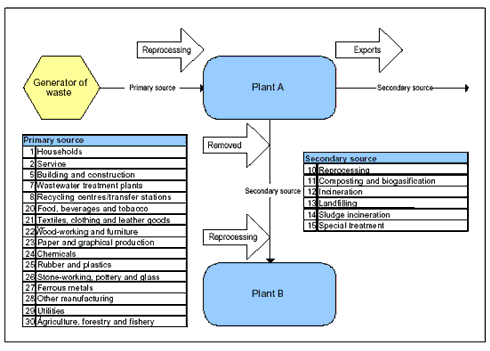
The Danish EPA carries out quality assurance of the information it receives and collects additional information from sector organisations and other sources. Each year the Danish EPA prepares a publication called “Waste Statistics”, which gives an overview of waste composition and waste arisings in Denmark. The publication also calculates the quantities of waste recycled, incinerated, and landfilled relative to the total waste amounts. Information is analysed between commercial sources and waste types. New methods Since 2001 data have been reported according to new rules set out in Statutory Order No. 619 of 27 June 2000 on waste (Statutory Order on Waste). These new rules have entailed a number of changes to the ISAG. For example, the source “manufacturing etc.” was discontinued, so that since 2001 breakdown of industrial waste has been divided between 11 sectors. Since 2001 there has been a shift between sectors in that waste volumes from industry have been falling, while waste volumes from the service sector have been rising. Waste volumes from industry thus fell by 30 per cent in the period 2001 to 2003, whereas in the service sector volumes increased by 27 per cent. In the period 2002 to 2003 waste volumes from industry fell by 20 per cent, whereas in the service sector volumes increased by 22 per cent. The shift between the two sectors may be due to faulty reporting as the source “manufacturing etc.” was discontinued from 2001 following the amendment of the Statutory Order on Waste [1]. This means that waste from industry must be reported as originating from one of the following 11 subgroups: food, beverages and tobacco; textiles, clothing and leather goods; wood-working and furniture; paper and graphical production; chemicals etc.; rubber and plastic; stone-working, pottery and glass; ferrous metals; other manufacturing; utilities; agriculture, forestry, fishery etc. It is likely that some carriers find it easier to report industrial waste as service-sector waste. This should be remembered when reading the statistics. Moreover, parties reporting to the ISAG are encouraged to be very attentive to this risk of incorrect reporting. Structural changes, that is the fact that society is changing from an industrial to a knowledge society, may be another reason for the shift between the two sectors. The shift could be supported e.g. by the fact that the number of new companies in traditional industry has gone down during the 1990s, while the number of new companies in the knowledge services industry has doubled. [2] Packaging waste is a new waste type in the ISAG and does not yet reflect the total amount of packaging waste in the form of cardboard and plastic collected for recycling in Denmark. Parties reporting to the ISAG are therefore encouraged to be especially aware of this reporting possibility. The principles for categorising waste from recycling centres/transfer stations with regard to the fractions glass and paper and cardboard have likewise been changed compared to the years 1994 to 2000. See Annex 2 for a more detailed explanation of the principles for this re-categorisation. From 2001, sludge for mineralisation has been stated with a dry matter content of 20 per cent. This means that sludge which is mineralised is included in the statistics with the same dry matter content as other sludge. In previous years dry matter content for sludge for mineralisation was 1.5 per cent. Please note that the changes to the way data is reported to the ISAG mentioned above, mean that care should be taken when comparing waste arisings at sector level from 2001 and later with waste arisings from previous years. The government's Waste Strategy 2005-2008 presents a shift in focus from use of waste arisings as the only indicator for target fulfilment, to the supplementary use of new waste indicators for resource loss and environmental impacts. Reading guide Waste Statistics 2003 follows the same structure as previous reports: Chapter 1 describes general trends in waste generation, while Chapter 2 deals with waste recycling. Chapter 3 deals with generation and treatment of hazardous waste, and Chapter 4 describes developments in imports and exports, both for ordinary waste and waste subject to mandatory notification. Chapter 5 describes developments in waste arisings and treatment of waste from individual sources. Furthermore, this Chapter assesses the level of achievement of targets for treatment in the Danish government's Waste Strategy 2005-2008. Chapter 6 presents the latest figures for the number of Danish incineration plants and landfills. Finally, Chapter 7 describes the new waste indicators and Chapter 8 presents a baseline projection of developments in waste arisings up to 2020. Tables are configured with leaps of two years for the first years, which is a new element to the report. This is due to visual scope and to make it possible to present the tables in a format big enough to read. Summary and conclusionsThe 2003 reporting to the ISAG comprises 403 plants owned by 273 enterprises. In 2002, reports covered 407 plants owned by 296 enterprises. Waste generation in 2003 is compared to targets from 2008 in the government's Waste Strategy 2005-2008. The following can be said to summarise waste generation in 2003:
1 Waste generation and treatment1.1 Waste generation 2003 and developments 2002-2003Waste generation in 2003 and developments in waste arisings from 2002 to 2003 are presented in Table 1. 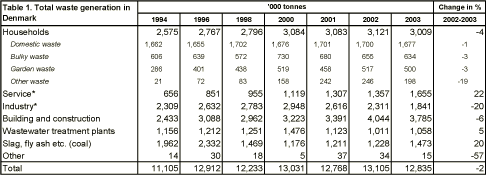
Source: ISAG; Danisco; the Association of Danish Recycling Industries and large scrap dealers; Elsam; Energi E2; and Reports to the Danish EPA on sludge from municipal wastewater treatment plants applied to farmland etc., and incineration of sludge at sludge incineration plants. (Sludge for recycling and incineration are represented by 2002 figures). Sludge are stated in wet weight, excluding however sludge for mineralisation which has been adjusted to 20 per cent dry matter. This applies to figures from 2001 and onward. Sludge for long-term storage has been included in sludge amounts applied to farmland etc. Sludge for recovery has been included in sludge amounts for incineration. The figures do not include imports of waste. Waste generation is stated as amounts of waste delivered to treatment plants from all primary sources. Primary sources include waste generators other than waste treatment plants (reprocessing plants, incineration plants, composting/biogas plants and landfills). Slag, fly ash and flue-gas cleaning products from waste incineration plants are therefore not included in the statement, as this would result in the waste being counted twice. Moreover, waste from the primary source recycling centres/transfer stations has been allocated among the other primary sources. The principles behind this allocation are explained in Annex 2. Other waste includes the fractions packaging waste, plastic, sludge, and electric and electronic equipment. *The figures pertaining to service and industry from 2001 and onwards should be interpreted with some reservation since there are fluctuations in the figures from the two sources which cannot be readily explained. In 2003, Danish waste generation amounted to 12,835,000 tonnes. This constitutes a 2 per cent fall relative to 2002. The fall primarily stems from a decline in industrial waste volumes of 20 per cent compared to 2002. However, as mentioned above there is great uncertainty linked to the development in industrial waste volumes. Furthermore, there has been a slight fall in the amount of waste from households and from building and construction. Waste from households amounted to 3,009,000 tonnes in 2003. This means a drop in waste generation of 4 per cent compared to 2002. All four waste types under household waste have gone down. Domestic waste arisings remain almost unchanged from previous years. As Table 1 shows, domestic waste arisings increased by 1 per cent during the period 1994 to 2002, showing only very slight changes from year to year [3]. Domestic waste includes separately collected paper, glass, organic waste, and other waste. The amount of bulky waste decreased by 3 per cent, or 21,000 tonnes, compared to 2002. The amount of waste reported as other waste fell by 19 per cent, which corresponds to 48,000 tonnes. From this report and onwards, the amount constituted by “other waste” includes packaging waste. Separated packaging waste became subject to reporting to the ISAG for the first time in 2001. However, this waste type is still not being reported to a sufficient extent. Therefore, packaging waste reported to the ISAG does not give a real picture of the total amount of collected packaging waste. Waste from the service sector amounted to 1,655,000 tonnes in 2003, which is 22 per cent more than in 2002. In absolute figures this is an increase of 298,000 tonnes. Waste from the service sector includes waste from institutions, trade and offices. The increase is apparent in the following fractions: waste suitable for incineration; waste not suitable for incineration; paper and cardboard; glass; hazardous waste; and other waste. These fractions have increased by 5 per cent, 7 per cent, 26 per cent, 47 per cent, 21 per cent, and 107 per cent respectively relative to 2002. The fractions: food waste/other organic waste; and healthcare risk waste show drops of 7 and 11 per cent respectively. Waste from industry [4] fell by 20 per cent. This involves a drop of 470,000 tonnes, from 2,311,000 tonnes in 2002 to 1,841,000 tonnes in 2003. The drop is primarily due to reductions in the following fractions: waste suitable for incineration; waste not suitable for incineration; paper and cardboard; plastic; ferrous metals; and sludge. These fractions have been reduced by 26 per cent, 27 per cent, 30 per cent, 5 per cent, 13 per cent, and 10 per cent respectively. By contrast, the fractions food waste/other organic waste; hazardous waste; and other waste have increased by 15 per cent, 44 per cent, and 16 per cent respectively. The amount of beet soil has neither gone up nor down. Since 2001 there has been a shift in waste arisings between service and industry, so that amounts of waste from the service sector have increased significantly while amounts of waste from industry have decreased to about the same extent. Amounts of waste from industry thus fell by 30 per cent in the period 2001 to 2003, whereas in the service sector volumes increased by 27 per cent. In the period 2002 to 2003 amounts of waste from industry fell by 20 per cent, whereas in the service sector volumes increased by 22 per cent. This shift between the two sectors may be due to faulty reporting, as the source manufacturing etc. was discontinued in 2001 as a result of the amendment of the Statutory Order on Waste [5]. This means that waste from industry must be reported as originating from one of the following 11 subgroups: food, beverages and tobacco; textiles, clothing and leather goods; wood-working and furniture; paper and graphical production; chemicals etc.; rubber and plastic; stone-working, pottery and glass; ferrous metals; other manufacturing; utilities; agriculture, forestry, fishery etc. It is likely that some carriers find it easier to report industrial waste as service-sector waste. Parties reporting to the ISAG are therefore encouraged to be aware of this possible source of incorrect reporting. Changes in the industrial structure, the fact that society is changing from an industrial to a knowledge society, may be another reason for the shift between the two sectors. The shift could be supported e.g. by the fact that the number of new companies in traditional industry went down during the 1990s, while the number of new companies in the knowledge services industry doubled. [6] The generation of waste in the building and construction sector decreased from 2002 to 2003. Volumes of building and demolition waste amounted to 3,785,000 tonnes in 2003, which is 259,000 tonnes, or 6 per cent, less than in 2002. The fall is primarily due to reductions in the fractions: not suitable for incineration; concrete; tiles; soil and stone; and other recyclable waste. These fractions were reduced by 24 per cent, 0.1 per cent, 13 per cent, 36 per cent, and 6 per cent respectively. Conversely, waste from the following fractions increased: other construction and demolition waste; asphalt; and other waste, which increased by 30 per cent, 28 per cent, and 19 per cent respectively. In 2003, 476,278 tonnes less soil and stone were reported. This is explained e.g. by the fact that the large operators in this area reported a significant decline in the market in the first half of 2003 leading to less waste from this fraction being received as opposed to in 2002. The second half of 2003 has been reported as normal. By far the major part, or 93 per cent, of waste generated by the building and construction sector is recycled. There has been a 5 per cent rise in the amount of sludge from municipal wastewater treatment plants: in 2003 the amount was 1,058,000 [7] tonnes, stated with a dry matter content of 20 per cent. This is 47,000 tonnes more than in 2002. From 2001, sludge for mineralisation has been included with a dry matter content of 20 per cent, so that this sludge is incorporated into the statistics with the same dry matter content as other sludge. In previous years, dry matter content for sludge for mineralisation was 1.5 per cent. Waste generation at coal-fired power plants increased by 20 per cent, which is an increase from 1,228,000 tonnes in 2002 to 1,473,000 tonnes in 2003. This is first and foremost due to the fact that energy generation was larger in 2003 than in 2002. The increase is due e.g. to the fact that in 2003 Denmark had net exports of electricity which constituted more than three times the total net exports in 2002. During the period 1996 to 2000, waste arisings from coal-fired power plants fell. This can be attributed e.g. to the fact that there has been a conversion of energy generation from coal to renewable energy resources. Denmark had net imports of electricity for the first time in this period in 2000 [8]. 1.2 Waste management in 2003In the following, developments in Danish management of total waste arisings are described. Waste management is compared to treatment targets in the Danish government's Waste Strategy 2005-2008. Table 2 shows that 8,439,000 tonnes, corresponding to 66 per cent of total waste arisings, were recycled in 2003. In absolute figures this is an increase of 57,000 tonnes, or 2 per cent, compared to 2002. 
Source: same as Table 1, and the Danish government's Waste Strategy 2005-2008. Waste led to incineration in 2003 amounted to 3,287,000 tonnes. This is actually a 57,000-tonne drop in waste amounts compared to the previous year, and it corresponds to 26 per cent of total waste arisings. Waste led to landfill in 2003 amounted to 981,000 tonnes, which is a decrease of 213,000 tonnes from 2002. The rate of waste landfilled amounts to 8 per cent of total waste arisings. The percentage share of waste led to landfill has fallen by 62 percentage points in the period 1994 to 2003, corresponding to a reduction in landfilled waste of 1,632,000 tonnes. As the table shows, the relative distribution in recent years among treatment options has varied only little. Variations are often explained by developments in waste arisings in individual fractions. For example, variations in amounts of residues from coal-fired power plants and construction and demolition waste have large implications on the total rate of recycling, as these two waste types account for a large percentage of total waste arisings and typically have a rate of recycling of 90 per cent or more. In the Danish government's Waste Strategy 2005-2008 the target of stabilising Danish waste generation is supplemented by a number of qualitative elements such as better exploitation of resources in waste, better quality in treatment of waste, and limitation of problems caused by environmental contaminants in waste. In general, targets for different sectors and individual fractions will mean an increased rate of recycling and incineration. Overall waste treatment targets for 2008 in the government's Waste Strategy 2005-2008 are 65 per cent recycling, 26 per cent incineration, and a maximum of 9 per cent landfilling. As can be seen from Figure 1, the overall targets for treatment of waste in 2008 were met in 2003. In 2003, one per cent of total waste arisings was reported under the treatment option storage. Storage means temporary landfilling of waste suitable for incineration until incineration capacity is available. The rate of recycling is one per cent above target, whereas incineration and landfilling meet the targets. The general fall in the rate of waste led to landfills can be attributed to the ban on landfilling of waste suitable for incineration that came into effect on 1 January 1997. However, there are other important factors. 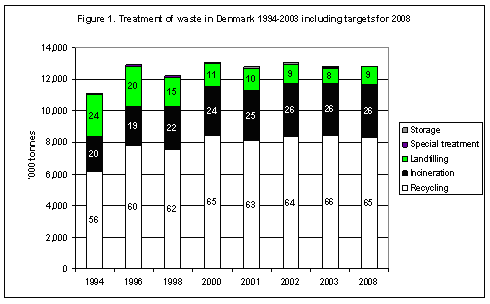
Source: same as Table 1. Note that total waste arisings in 2008 have been set to correspond to waste arisings in 2003. The figures for 2004 are not projections of developments in total waste arisings. Amounts of residues from coal-fired power plants have decreased significantly, and moreover they are being recycled to a larger extent than in previous years when they were mainly landfilled. 1.3 Treatment of waste without residues and construction and demolition wasteAmounts of residues from coal-fired power plants not only depend on energy consumption in Denmark, but also on exports of electricity to Sweden and Norway. In addition, due to the strategy of the past 10 years to phase out coal, a still larger shift is taking place from use of coal and coke to use of natural gas and renewable energy. Since 1996, when Denmark's electricity exports to Sweden and Norway were particularly large, amounts of residues have decreased steadily up until 2000. In fact, this is a 786,000-tonne decrease (see Table 29), corresponding to a 40 per cent reduction 40. In the period 2002 to 2003 there was an increase of 245,000 tonnes which is probably primarily a result of increasing exports of electricity e.g. to Sweden and Norway. [9] Naturally, this has an impact on developments of total waste arisings, but as residues have a very high rate of recycling, it also has an impact on the ability to meet overall treatment targets. A similar picture is seen for construction and demolition waste. As discussed in section 5.4, the rate of recycling of construction and demolition waste typically reaches around 90 per cent. Therefore, it is interesting to look at the distribution of waste between the different treatment options, if residues and construction and demolition waste are excluded from the statistics. Figure 2 shows the distribution between the different treatment options when residues from coal-fired power plants are excluded from the statistics. 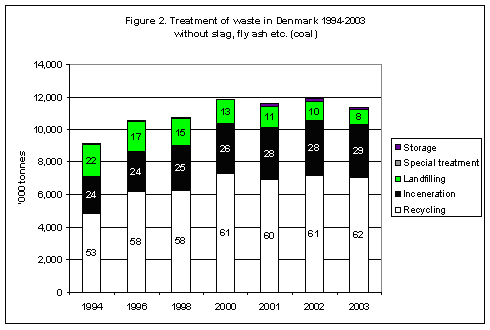
Source: Same as Table 1. When residues are excluded it is seen that 62 per cent of the remaining waste was recycled in 2003, which is a decrease of 107,000 tonnes from 2002. This should be seen in context with the fact that total waste arisings have fallen. The rate of remaining waste incinerated in 2003 is 29 per cent, which is to say that 7,000 tonnes less waste were incinerated in 2003 than in the year before. The rate of waste for landfilling is 8 per cent, which is a 109,000-tonne reduction compared to 2002. In absolute figures this means that in 2003, apart from residues, 11,597,000 tonnes of waste were generated, corresponding to a drop of 2 per cent from 2002. Of these, 7,085,000 tonnes were recycled, whereas 3,337,000 tonnes were incinerated, and 1,047,000 tonnes were landfilled. Moreover, 20,000 tonnes were given special treatment and 108,000 tonnes have been temporarily landfilled until incineration capacity becomes available [10]. Total waste amounts without waste from coal-fired power plants increased by 25 per cent from 1994 to 2003. Waste from the building and construction sector has also been excluded from statistics in Figure 3. This causes an increase in the rate of remaining waste for recycling, whereas the rates for incineration and landfilling decrease. In absolute figures, waste generation without residues and without waste from construction and demolition amounted to 7,814,000 tonnes in 2003, which is 20,000 tonnes, or 1 per cent, less than in 2002. In other words, if residues and waste from building and construction are excluded, there has been a fall in total waste arisings. Residues from coal-fired power plants and construction and demolition waste are recycled to a very large extent: in 2003, 97 per cent and 93 per cent respectively, cf. Chapter 5. It is seen that these two fractions play a very significant role in the compliance with overall waste treatment targets in the Danish government's Waste Strategy 2005-2008. 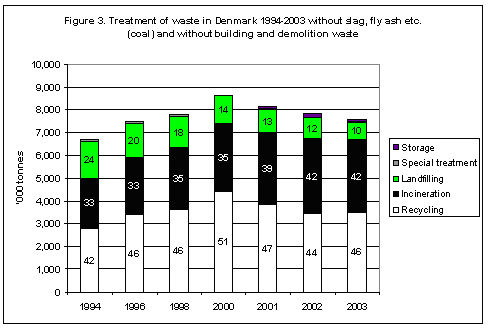
Source: Same as Table 1. 1.4 Treatment by source and waste typeFigure 4 shows total waste generation in 2003 analysed by source and treatment option. Figure 5 shows waste generation distributed by waste type and treatment option. Tables with detailed figures are given in Annex 1. Figure 4 shows that especially waste from the building and construction sector, coal-fired power plants and wastewater treatment plants is characterised by very high recycling rates. So targets for recycling in the Waste Strategy 2005-2008 have been met for waste generated by these three sectors. The rate of recycling of waste from industry is also relatively high: 63 per cent compared to a target of 65 per cent recycling. The high rate of recycling, however, is especially attributable to recycling of ferrous metals. Too much waste from this sector is still being led to landfill, namely 21 per cent against the target of only 15 per cent, and a challenge lies ahead to divert larger amounts of the other fractions from landfilling to incineration or recycling. The rate of recycling of waste from the service sector is likewise too low compared to the 2008 target of 50 per cent recycling. In 2003, only 44 per cent of the waste was recycled. This, however, constitutes a significant rise from 2002, when only 36 per cent was recycled. The target of 45 per cent incineration has been met. Waste in temporary storage for later incineration when capacity becomes available constitutes 2 per cent. Too much waste is landfilled: 8 per cent against the target of 5 per cent. The challenge for the service sector is to divert more waste from landfilling to recycling. Treatment of the waste type domestic waste also does not comply with the targets in the Waste Strategy 2005-2008, cf. Figure 5. Only 16 per cent of this waste was recycled in 2003. In the period 1994 to 2002 the recycling rate fluctuated between 14 per cent and 17 per cent. 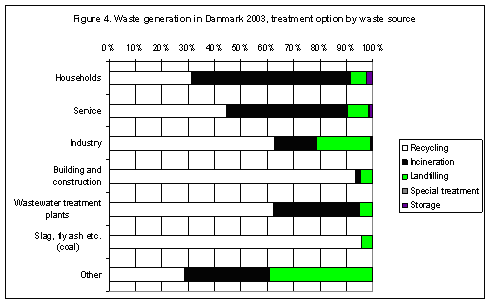
Source: Same as Table 1. The target is to reach a recycling rate for domestic waste of 20 per cent in 2008, whereas the targets for incineration and landfilling are 80 per cent and 0 per cent respectively. The rate of domestic waste incinerated in 2003 reached 83 per cent, whereas about 2 per cent was led to landfill [11]. 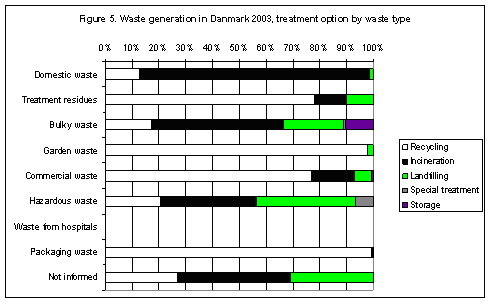
Source: Same as Table 1. 1.5 Developments in waste generation 1994-2003Table 3 shows total waste arisings in Denmark for the years 1994 to 2003. Breakdown of the information is by commercial sources. There was a 16 per cent increase in total waste arisings in the period 1994 to 2003. Waste generation was largest in 2002. The reduction in 2001 in waste arisings should be seen in context with the changes in methods applied. Waste arisings showed some fluctuations in the period 1994 to 2003, however they have been steady at around 13 mill. tonnes in recent years. The increase in the first half of the 1990s may be due partly to the fact that coverage of the ISAG system increased and partly due to real increases in waste arisings. The large amounts of waste in 1996 were primarily due to particularly high amounts of residues from coal-fired power plants in 1996, which in turn were due to large exports of electricity to Sweden and Norway. However, increasing waste arisings in 2000 must be attributed to an increase in waste from households and waste from building and construction. The same applies for 2002. 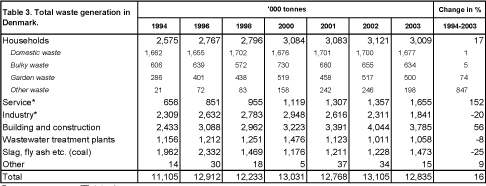
Source: Same as Table 1. Other includes e.g. packaging waste, plastic, sludge, and electric and electronic equipment. 2 Recycling2.1 Recycling by fractionTable 4 shows the amounts separated from the different waste fractions for the purpose of recycling in the form of either reprocessing, composting or biogasification. The Table does not show the total amount of waste generated by the individual fraction. 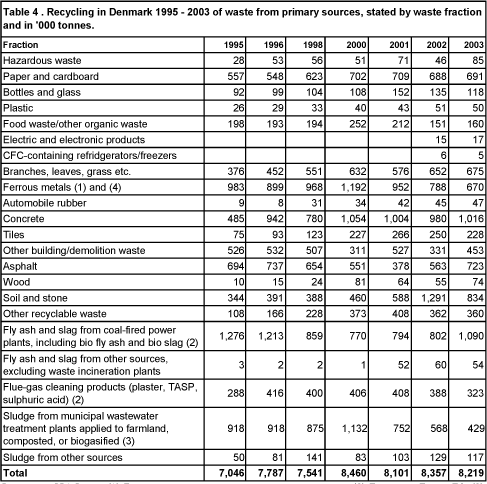
Source: the ISAG and (1) Recycling industries and other large scrap dealers. (2) Elsam and Energi E2. (3) Reports to the Danish EPA on sludge from municipal wastewater treatment plants applied to farmland etc. Data has been delayed a year so that 2002 figures are used for 2003, and 2001 figures are used for 2002, and so on. Sludge for long-term storage has been included in the amount for recycling. (4) To avoid double reporting, figures have been corrected for ferrous metals removed from waste incineration plants. As the table shows, 8,219,000 tonnes of waste were recycled in 2003, which is 2 per cent or 138,000 tonnes less than in 2002. This fall is especially due to less recycling of soil, stone, and sludge from municipal wastewater treatment plants, and ferrous metals. However, at the same time a number of waste fractions show increases, including concrete, asphalt, as well as fly ash and slag from coal-fired power plants. 2.2 Paper and cardboardConsumption of virgin paper and the rate of collection of waste paper in the period from 1994 to 2003 are shown in Table 5. Total collected waste paper in 2003 amounted to 691,000 tonnes. This is an increase of 3,000 tonnes, or of less than one per cent, compared to the total amount collected in 2002. 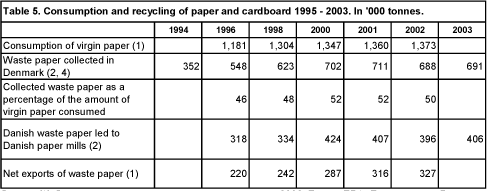
Source: (1) Statistics on collected waste paper and cardboard 2002. Danish EPA, Environmental Project No. 937, 2004. (2) The ISAG reports. (3) Statistics Denmark. In Waste Statistics 2001, net exports of collected waste paper were stated as 258,000 tonnes. The final figure from Statistics Denmark is 316,000 tonnes. (4) Some of the increase from 1998 to 2000 is explained by a correction of reporting to the ISAG. Thus, about 100,000 tonnes were diverted from secondary sources to primary sources in connection with a quality control of reporting in 2000. The relevant waste treatment plants have (probably) also reported incorrectly in previous years, which may account in part for the previous differences in amounts of collected waste paper in statements based respectively on the ISAG and material flow monitoring of collected waste paper (Danish waste paper delivered to Danish paper mills and Net exports of waste paper). The rise in the amount of waste paper from trade/offices and the drop in the amount of paper from households are probably due to problems with reporting of waste split between primary and secondary sources. In connection with quality control, e.g. Smørum Papir stated that they no longer receive waste paper from households. This alone means a fall of 45,000 tonnes from 2000. Apparently, no other plant has reported a compensating increase. Table 6 shows collected paper by source and by packaging waste and remaining waste types. Not surprisingly, the largest amounts of waste paper are collected from households, the service sector and industry. The largest amounts of packaging waste are collected from industry. 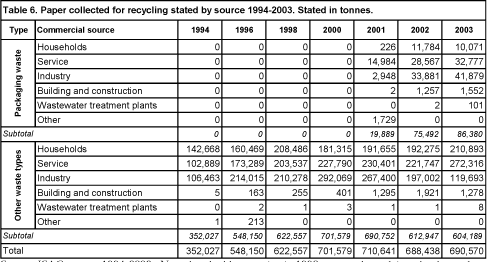
Source: ISAG reports 1994-2003. Note that double reporting in 1998 apparently explains why the total amount is 20,000 tonnes too high. The total amounts of waste paper and cardboard for 2000 and 2001 were reported incorrectly in Waste Statistics 2001. Corrected figures are shown in Table 6. Packaging waste is a new waste type in the ISAG and it does not yet reflect the total amount of cardboard packaging waste collected for recycling in Denmark. In 2002, 308,000 tonnes of paper and cardboard packaging waste were collected for recycling [12]. The amount of waste paper collected from households went up by 16,905 tonnes from 2002 to 2003. From 1998 to 2000, the amounts of collected waste paper from households remained stable at around 180,000 tonnes [13]. From 2001 and onward the amount increased to around 221,000 in 2003. The amount of waste paper collected from the service sector has gone up by around 54,779 tonnes, or 22 per cent, amounting to 305,093 tonnes in 2003. The amount of paper collected from industry has fallen by around 69,311 tonnes corresponding to 30 per cent compared to 2002. In the ISAG, waste delivered to a recycling centre/transfer station is reported with the commercial source “recycling centre/transfer station”. This means that it is not stated whether the waste originated from households or from other primary commercial sources. From 2001, recycling centres/transfer stations must indicate a split between waste types and primary source. Since this is not yet routine, the ISAG Secretariat has divided the waste as shown in Annex 2. 2.3 PlasticTable 7 shows the amount of plastic collected for recycling, reported to the ISAG. In 2003 this amount was 49,941 tonnes, which is a fall of around 682 tonnes from 2002. However, it is assumed that some plastic has been collected and exported directly for recycling abroad without having been registered at a Danish treatment plant. It is therefore probable that the amount of waste plastic collected in Denmark is higher than 49,941 tonnes. 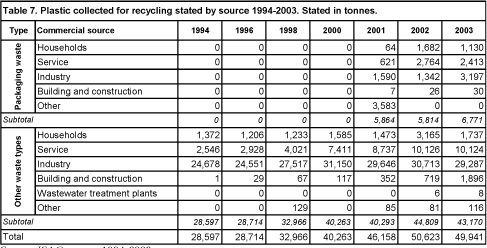
Source: ISAG reports 1994-2003. The fraction plastic covers both production waste, plastic packaging waste, and other plastic waste, with individual figures shown in Table 7. Packaging waste is a new waste type in the ISAG and it does not yet reflect the total amount of waste plastic packaging collected for recycling and reprocessing in Denmark. Therefore, in the following description of plastic recycling, ISAG figures have been supplemented with information from more detailed statistics on waste plastic packaging. Statistics for waste plastic packaging in 2002 [14] show that 21,104 tonnes of waste plastic packaging were reprocessed in Denmark in 2002. Half of this amount was imported. In 2002, 24,409 tonnes of waste plastic packaging were collected and recycled in Denmark. Of this amount, 14,382 tonnes were exported for recycling abroad. The total amount collected corresponds to 15.5 per cent of the total Danish consumption of plastic packaging. This is a slight increase from 2001, when 13.9 per cent of waste plastic packaging was collected for recycling. Waste plastic of the type polyethylene (PE) accounted for 83 per cent of collected amounts. 2.4 Bottles and glassAccording to the ISAG reports, 117,826 tonnes of bottles and glass were collected for recycling in Denmark in 2003. This is 17,175 tonnes less than in 2002. The fall is explained by the fact that glass as a packaging type increasingly is being replaced by other types of packaging, e.g., plastic. [15] As seen in Table 8, the amount of glass collected for recycling went up by 8,298 tonnes, or 8 per cent, during the period 1994 to 2003. However, the figures fluctuate somewhat throughout the period. At the same time it is seen that the amount of glass packaging collected from households has dropped significantly in the period 2001 to 2003. 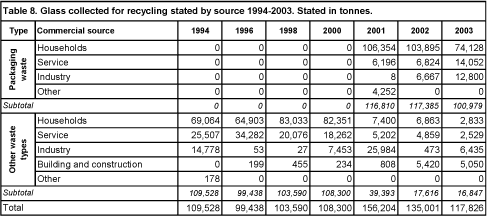
Source: ISAG reports 1994-2003. It is evident from Table 8 that by far the major part of the glass collected is packaging waste: thus, packaging waste accounted for 86 per cent of the total amount of glass in 2003. However, the ISAG does not provide a complete picture of the overall material flow. This is especially significant with regard to recycling of bottles and glass, which is a process comprising several collection, reuse and treatment steps before glass becomes waste. Therefore, in the following description of overall glass recycling, ISAG information is supplemented with information from Statistics on glass packaging 2002 [16], cf. Figure 6. 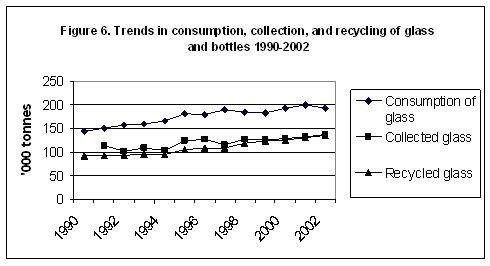
Source: Statistics on glass packaging 2002. Environmental Project No. 935, 2004. Note that total consumption for 1999 has been adjusted to reflect Statistics on glass packaging 1999. The adjustment is due to a write up of amounts of glass packaging for food preservation. Apart from minor fluctuations, consumption of glass packaging increased throughout the 1990s. Correspondingly, the amount of glass packaging collected and recycled has increased. Collected glass amounted to 132,000 tonnes in 2001 but rose to 137,000 tonnes in 2002. Amounts of recycled glass also increased, namely from 130,000 tonnes in 2001 to 135,000 tonnes in 2002. This means that in 2002 the collection rate as a percentage of total consumption reached 70 per cent, which is an increase of 5 percentage points compared to 2001. In 2001, the recycling rate as a percentage of total consumption reached 65 per cent. Bottles for beer and soft drinks manufactured for reuse are not included in this statement. Refillable glass bottles, on average, make 30 trips. If these bottles were manufactured as single-use bottles, it would give an increase in waste glass of around 310,000 tonnes. 2.5 Ferrous metalsTable 9 shows the overall amount of ferrous scrap collected, analysed between consignees. It is seen that 857,000 tonnes of ferrous metals were recycled in 2003, which is an increase of 139,000 tonnes, or 19 per cent, from 2002. Table 9 shows a drop of 106,000 tonnes, or 91 per cent, in the amount of ferrous scrap imported by foundries and the Danish Steel Works. The Association of Danish Recycling Industries has reported that ferrous scrap not sent to the Danish Steel Works has been exported. We do not have more precise data on the total recycling potential for ferrous scrap. However, the Association of Danish Recycling Industries normally estimates a recycling rate for ferrous scrap in excess of 90 per cent. According to reports to the Danish EPA, the Danish Steel Works and other Danish foundries imported 10,000 tonnes of ferrous scrap in 2003, whereas scrap dealers imported around 142,000 tonnes. In other words, total imports in 2003 amounted to 152,000 tonnes, which is 40,000 tonnes, or 21 per cent, less than in 2002. Scrap dealers exported 738,000 tonnes of ferrous scrap in 2003, which means that net exports in 2003 were 596,000 tonnes. This is an increase of 11 per cent from 2002. 2.6 Organic waste for composting, wood chipping and biogasificationThe amount of organic waste led to reprocessing in the form of composting, wood chipping, biogasification, or fodder is shown in Table 10. Organic waste led to reprocessing in 2003 amounted to 1,306,000 tonnes. This is 22,000 tonnes more than in 2002. The increase is due to in particular to the amount of branches, leaves etc. for composting, which rose by 31,000 tonnes. The amount of bark/wood chips and compost removed from treatment plants does not reflect the total amount generated at the plants. Rather, this amount indicates the quantity sold or delivered free from the plants. As is seen from the table, the amount of sold/removed bark/wood chips came to around 12,000 tonnes more in 2003 than in 2002, whereas the amount of sold/removed compost was 11,000 tonnes less than in 2002. 2.7 TyresIn 1995, the Minister for Environment and Energy entered an agreement with a number of organisations, on a take-back scheme for used tyres from cars, vans, and motorcycles. The purpose of the agreement is to ensure collection and recycling of used tyres in Denmark. Landfilling is avoided and resource recovery ensured, whereby recycling is prioritised over energy recovery. The scheme started on 1 April 1995 and is financed by a fee on all tyres covered by the agreement and marketed in Denmark. According to the agreement, the target is a take-back rate of at least 80 per cent. From 1 April 2000 the scheme was extended to cover tyres from all types of motor vehicles. This accounts for the leap in data from 1999 to 2000 in Table 11. The table shows that the collection rate for waste tyres surpassed 100 per cent in 2002. According to reports from the Danish Tyre Trade Environmental Foundation, this is presumably due to the fact that waste tyres have been imported from Germany, as well as to the fact that some waste tyres have been collected and stored for several years. 
Source: reports from the Danish Tyre Trade Environmental Foundation in 1996, 1997, 1998, 1999, 2000, 2001, 2002 and 2003. 3 Hazardous wasteTable 12 shows treatment of hazardous waste in 2002 and 2003 by main group. The statement covers waste from both primary and secondary sources. A more detailed statement of hazardous waste, analysed by the ISAG fraction is in Annex 4. Table 12 has been changed somewhat from previous years to make it more comprehensible. This means that certain fractions are now only found in Annex 4. Waste from secondary sources, such as waste from incineration plants, is not included in total waste generation, cf. Table 1. This is because the waste would otherwise be counted twice in the statistics: the first time upon receipt at the primary treatment plant and the second time as a residue. However, it may be reasonable to include waste from both primary and secondary sources when estimating capacity needs for hazardous waste management. The table shows that hazardous waste from primary sources amounted to 328,349 tonnes in 2003. This is an increase of 80,848 tonnes from 2002. The increase is primarily attributable to the fractions: other hazardous waste, waste oil, and flue-gas waste. The waste category other hazardous waste shows an increase of 104,736 tonnes from 2002 to 2003. The major part of this increase originates from industry, which is seen in Table 15. Here we see an increase of 102,401 tonnes from 2002 to 2003 in the amount led to landfills. The significant increase is explained by the fact that shredder waste is landfilled free of tax. Waste which is landfilled free of tax cannot be categorised as shredder waste in the ISAG. This waste is therefore reported as other hazardous waste. From 2000 to 2001, the amount of hazardous waste increased by 57 per cent. However, by far the major part of this increase was due to changes in the method of reporting to the ISAG. From 2001 shredder waste must be reported to the ISAG separately. Previously this waste type was categorised as part of the non-hazardous fraction, “various non-combustible”. Shredder waste amounted to 67,232 tonnes in 2002. In 2003 it amounted to 0 tonnes [17] Hazardous waste from secondary sources amounted to 88,136 tonnes in 2003, which is 2,290 tonnes more than in 2002. Tables 13 to 16 show the amounts of waste generated by the four sectors: households, service, industry, and building and construction. 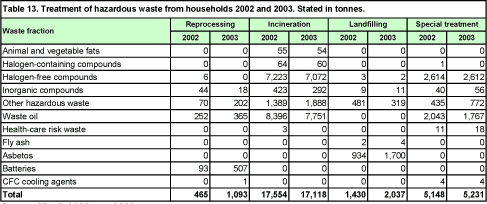
Source: ISAG 2002 and 2003. 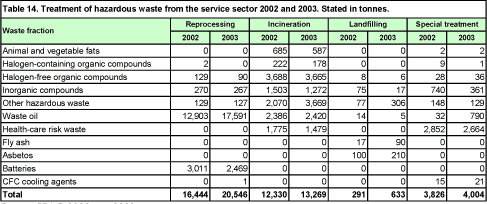
Source: ISAG 2002 and 2003. 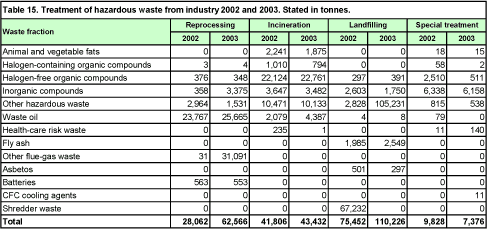
Source: ISAG 2002 and 2003. 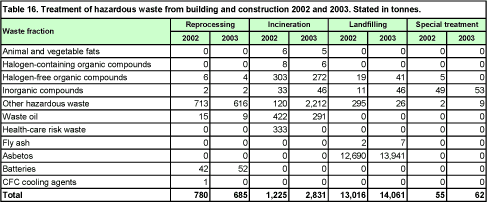
Source: ISAG 2002 and 2003. The total amount of hazardous waste from industry is 223,600 tonnes, whereas the total amount from the service sector is around 38,000 tonnes, the total amount from households is around 25,000 tonnes, and the total amount from building and construction is around 18,000 tonnes. A comparison of the total amounts of hazardous waste from the four sectors shows that industry generated almost three times as much hazardous waste as the three remaining sectors put together. The building and construction sector, which generates least hazardous waste, has one primary source of hazardous waste, namely asbestos. Asbestos is also present in other sectors, however in significantly smaller quantities. Healthcare risk waste from the service sector, or more precisely from hospitals, is another hazardous waste fraction primarily originating from one sector. The three fractions waste oil, halogen-free organic compounds, and other hazardous waste occur in the largest amounts in industry, the service sector, and households. Inorganic compounds without halogens include e.g. solvents, dye/varnish/paint and tar, and rust-preventing oils. Inorganic compounds are found in significant amounts in both industry and the service sector. This fraction is found only in small amounts in both households and the building and construction sector. 4 Imports and exports of waste4.1 ImportsTable 17 shows the amount of waste imported to Denmark in 2002 and 2003 by waste fraction and treatment option. In 2003, 503,387 tonnes of waste were imported, which is 107,837 tonnes more than in 2002. The amount of waste imported in 2003 corresponds to around 4 per cent of total waste generated in Denmark. This is one percentage point more than in 2002, where imported waste corresponded to 3 per cent of the total waste generated in Denmark. 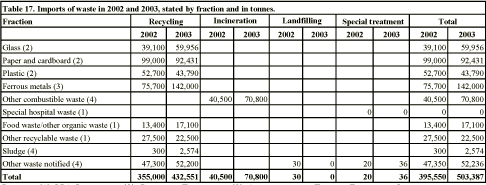
Source: (1) ISAG reports; (2) Statistics Denmark; (3) Association of Danish Recycling Industries and other large scrap dealers; (4) registrations under the EU regulation on shipments of waste: Council Regulation No. 259/93 on the supervision and control of shipments of waste within, into and out of the European Community. Around 70 per cent of imported waste is categorised pursuant to the EU regulation on shipments of waste [18] as so-called green waste for recovery. Green waste covers primarily glass, paper and cardboard, plastic, ferrous metals, and organic waste. Green waste is not subject to mandatory notification under the EU regulation on shipments of waste. Waste imported belonging to the category “other combustible waste” is destined for incineration with energy recovery, and comprises different types of waste oil. This is waste subject to mandatory notification and it is therefore also included in Table 19. 4.2 ExportsTable 18 shows the amount of waste exported from Denmark in 2002 and 2003. The amount of waste exported from Denmark in 2003 corresponded to around 13 per cent of the total waste generated in Denmark. In 2003, waste exports amounted to 1,642,188 tonnes, or around 268,058 tonnes more than in 2002. The increase is especially attributable to an increase in exports of other combustible waste, the major part of which is waste from the manufacturing and processing of meat, fish, and other foods of animal origin. A detailed statement of the amount of exported waste subject to mandatory notification is found in Table 19. Around 62 per cent of waste exported from Denmark in 2002 belongs to the category “green waste for recovery”. This category includes the fractions glass, paper and cardboard, plastic, and ferrous metals. 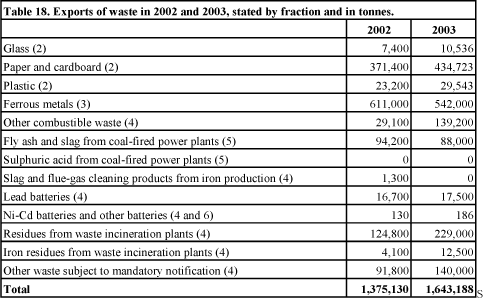
Source: (1) ISAG reports; (2) Statistics Denmark; (3) Association of Danish Recycling Industries and other large scrap dealers; (4) registrations under the EU regulation on shipments of waste: Council Regulation No. 259/93 on the supervision and control of shipments of waste within, into and out of the European Community; (5) Elsam and Energi E2; (6) the Danish EPA registered 110 tonnes of Ni-Cd batteries collected in 2002 and 62 tonnes in 2003. 4.3 Imports and exports of waste subject to mandatory notificationTable 19 shows the countries to and from which Denmark has exports and imports of waste subject to mandatory notification. Waste subject to mandatory notification means waste that must be notified to the competent authorities of dispatch and the competent authorities of destination according to Council Regulation No. 259/93 on the supervision and control of shipments of waste within, into and out of the European Community. As can be seen from the table, in 2003 Denmark imported 35 tonnes of waste for disposal, which is about 9 tonnes less than in 2002. This waste originated from Ireland, Norway, and Sweden, and primarily consisted of other waste, peroxides, and PCB waste. In 2003, Denmark imported around 125,600 tonnes of waste for recovery. Most of this waste originated from Norway and Sweden and primarily consisted of waste oil and alkaline solutions etc. The amount of imported waste in 2003 destined for recovery rose by 37,809 tonnes compared to 2002, when around 87,806 tonnes of waste were imported. Waste subject to mandatory notification exported for disposal amounted to 308,819 tonnes in 2003, which is 158,943 tonnes more than in 2002. This waste was exported to Norway, Germany, and Turkey and primarily consisted of residues from incineration plants. In addition, Denmark exported 211,853 tonnes of waste subject to mandatory notification destined for recovery. This is around 94,118 tonnes more than in 2002. Countries of destination were primarily Sweden and Germany. The waste types concerned were mainly waste from processed cork and wood, lead batteries, and other waste. 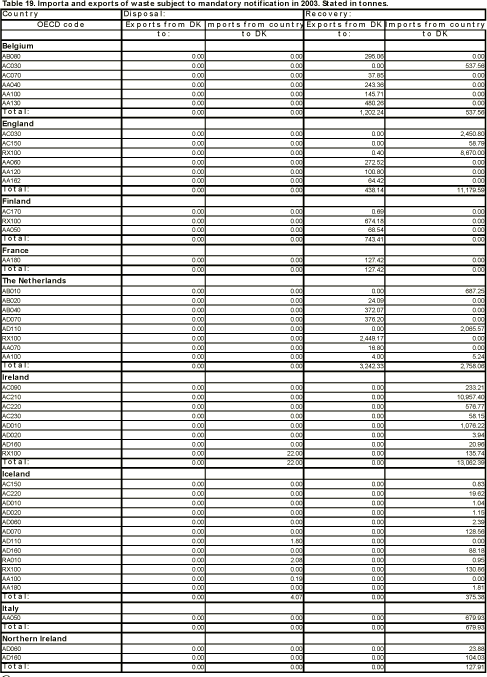
Cont. 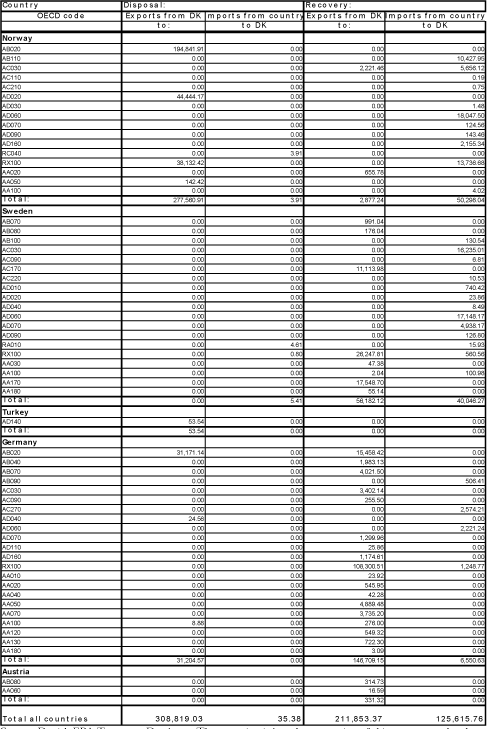
Source: Danish EPA Transport Database. The reporting is based on reporting of shipments completed under the EU regulation on shipments of waste (Council Regulation No 259/93. The competent authorities of destination must submit copies of the completed consignment note to the competent authorities involved no later than 3 days from receipt of the waste. No later than 180 days after receipt of the waste, the consignee must send proof that the waste has been recovered. OECD waste codes are described in detail in Commission Decision of 21 October 1994 (OJ 1994 L288/36). The table has been changed compared to Waste Statistics 2002. OECD waste codesAA010 Dross, scalings and other wastes from the manufacture of iron and steel. AB010 Slag, ash and residues, not elsewhere specified or included. AC010 Waste from the production/processing of petroleum coke and bitumen, excluding anode butts. AD010 Wastes from the production and preparation of pharmaceutical products. RA010 Wastes, substances and articles containing, consisting of or contaminated with polychlorinated biphenyl (PCB) and/or polychlorinated terphenyl (PCT) and/or polybrominated biphenyl (PBB),
including any other polybrominated analogues of these compounds, at a concentration level of 50 mg/kg or more. RB010 Asbestos (dusts and fibres). RC010 Wastes that contain, consist of or are contaminated with any congenor of polychlorinated dibenzo-furan RX100 Other wastes not specified with an OECD code. 5 Individual waste sources and status in relation to targets for 20085.1 Waste generated by householdsWaste from households covers the waste types domestic waste, bulky waste, and garden waste, which in turn are divided into individual fractions, e.g. paper and cardboard, bottles and glass, and food waste/other organic waste. Table 20 shows waste arisings by mixed and separately collected fractions to the extent it has been possible to register these individually. This means, for example, that the amount of paper and cardboard stated does not show the complete potential in household waste arisings but only the amount which has been separated and collected for recycling. The rest of the paper is part of the fraction various combustible. Waste arisings in households in 2003 amounted to around 3,000,000 tonnes, which constitutes a 4 percentage point drop from 2002. The reduction in total household waste arisings is therefore to be found mainly in bottles and glass separated for recycling, which have fallen by 31 per cent. The fraction various combustible, however, still makes up the largest part of total household waste arisings, namely around 63 per cent. Table 20 shows several shifts between the different household waste fractions, so that paper and cardboard separated for recycling, food waste/other organic waste, hazardous waste, and ferrous metals have increased by 8 per cent, 2 per cent, 48 per cent, and 4 per cent respectively, whereas various combustible, various non-combustible, bottles and glass, garden waste, and other waste have decreased by 3 per cent, 7 per cent, 31 per cent, 4 per cent, and 8 per cent respectively compared to 2002. 5.1.1 Household waste per capita and per householdIn Table 21, household waste arisings are stated per capita and per household. Furthermore, the Table shows total arisings analysed between selected waste types and separately collected waste fractions. Total household waste generation per capita amounted to 559 kg in 2003, which is 22 kg less than in 2002. Household waste per household was 1,220 kg in 2003. Of these, domestic waste per capita and per household was 312 kg and 680 kg respectively in 2003. Compared to 2002, this means a slight fall of 5 kg per capita, while the amount per household fell by 12 kg. 5.1.2 Domestic wasteDomestic waste from households covers ordinary waste from private household consumption. This includes paper, bottles, glass, organic food waste and other waste. Usually, domestic waste is collected from households at regular intervals, once a week or once every other week. As mentioned in Chapter 1, domestic waste amounted to 1,677,000 tonnes in 2003, which is 23,000 tonnes less than in 2002. Since 1994, the amount of domestic waste has varied slightly from year to year, however, without showing any clear trend. The amount has increased by 1 per cent over the entire period, cf. Table 3. In 2003, 16 per cent of domestic waste was recycled, whereas 83 per cent was incinerated and 1 per cent landfilled. The breakdown by treatment option therefore shows slight changes from 2002 when 82 per cent was incinerated and 2 per cent landfilled. For the early years, packaging waste is included as part of the waste type domestic waste. To make comparison with these early years possible, packaging waste from households in 2001, 2002, and 2003 of 107,000, 117,000, and 85,000 tonnes respectively has been included in Figure 7. 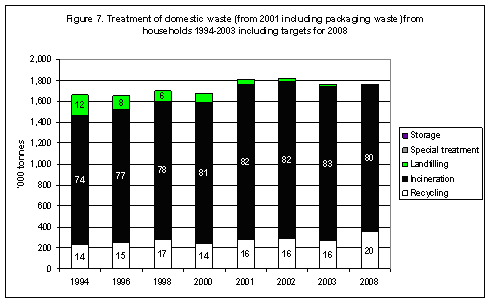
Source: same as Tables 1 and 2. Note that arisings in 2008 have been set to correspond to arisings in 2003. The figures are not projections of developments in waste arisings. As the table shows, the relative distribution in the period 1994 to 2003 among treatment options has varied only little. Considering the whole period, the trend since 1994 has shown that around 80 per cent of domestic waste is incinerated, whereas about 15 per cent is recycled and about 5 per cent is landfilled. This means that we are still incinerating and landfilling too much domestic waste compared to the targets in Waste Strategy 2005-2008 It should be noted that domestic waste is considered suitable for incineration and it is therefore not to be landfilled. If not recycled, domestic waste is to be incinerated. However, islands that are not connected by land to an incineration plant are exempt from this obligation. 
Source: same as Tables 1 and 2. Note that arisings in 2008 have been set to correspond to arisings in 2003. The figures are not projections of developments in waste arisings. 5.1.3 Bulky wasteBulky waste generated by Danish households amounted to 634,000 tonnes in 2003. This is 21,000 tonnes less than in 2002. In other words, there has been a fall of 3 per cent. During the period from 1994 to 2003 bulky waste increased by 5 per cent. Since 2000, the amount of bulky waste has shown a downward trend, cf. Table 3. The increase in bulky waste amounts is partly due to a real increase, but also to a significant extent to the establishment of waste-collection and waste-delivery schemes for bulky waste. Figure 8 shows bulky waste analysed between three treatment options: landfilling, incineration, and recycling for the period 1994 to 2003. The period 2000 to 2003 shows an almost unchanged distribution between treatment options: incineration around 49 per cent, landfilling around 27 per cent, recycling around 17 per cent, and, finally, 7 per cent in storage. 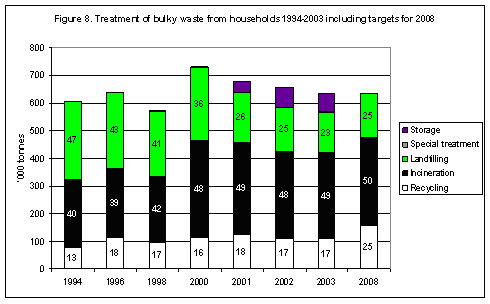
Source: same as Tables 1 and 2. Note that arisings in 2008 have been set to correspond to arisings in 2003. The figures are not projections of developments in waste arisings. In 2003, 49 per cent of bulky waste was incinerated, the rate for landfilling fell to 23 per cent, and the rate for recycling is 17 per cent. The remaining 11 per cent has been placed in temporary storage until incineration capacity becomes available [19]. This means that the real incineration rate for bulky waste is higher than 49 per cent. At the same time, the figures show that the amount of waste led to landfill has gone down considerably since 1994. The target of a maximum landfilling rate of 25 per cent has thus been met. However, too much bulky waste is still being incinerated and not enough is being recycled. If targets for treatment in 2008 are to be met, considerable efforts are required to separate and collect more of the different waste fractions in bulky waste. A number of initiatives covering e.g. cardboard, waste electronic and electrical equipment, impregnated wood and PVC-containing waste have or are in the process of being implemented. 
Source: same as Tables 1 and 2. Note that arisings in 2008 have been set to correspond to arisings in 2003. The figures are not projections of developments in waste arisings. Storage means that the waste in question has been assigned to temporary storage by local authorities (the local council), cf. section 37(3) of the Statutory Order on Waste. Denmark has excess incineration capacity, but storage can be due to e.g. repairs or shut down of operations at plants. 5.1.4 Garden wasteGarden waste collected from households in 2003 amounted to 500,000 tonnes, which is 17,000 tonnes less than in 2002, corresponding to a fall of 3 per cent. Throughout the 1990s the amount of garden waste increased steadily. From 1994 to 2003 the amount went up 74 per cent. This increase does not reflect a real increase in garden waste. It is rather the result of increasing opportunities for householders to dispose of garden waste at municipal waste treatment plants at the expense of home-composting. This means larger waste volumes to be treated in the municipal waste treatment system. Treatment of garden waste is presented in Figure 9. In 2001, 99 per cent of garden waste was recycled, and 1 per cent was landfilled. 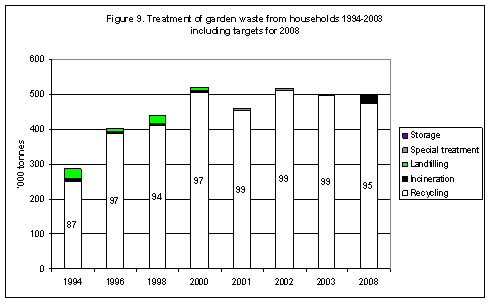
Source: same as Tables 1 and 2. Note that arisings in 2008 have been set to correspond to arisings in 2003. The figures are not projections of developments in waste arisings. 
Source: same as Tables 1 and 2. Note that arisings in 2008 have been set to correspond to arisings in 2003. The figures are not projections of developments in waste arisings. So, the targets for recycling and incineration of garden waste from households have been met by a good margin. Estimates indicate that it is impossible to increase the recycling rate any further. Future efforts with respect to garden waste will therefore concentrate on retaining the present high recycling rate and reducing the volumes treated in the municipal waste treatment system. Garden waste may be home-composted without permission from the local council, providing the regulation is complied with. Waste incineration is only allowed in plants that have been approved for the purpose. 5.2 Waste from the service sectorWaste from the service sector [20] amounted to 1,655,000 tonnes in 2003, which is 298,000 tonnes, or 22 per cent, more than in 2002. As mentioned in Chapter 1, there is however uncertainty as to the increase and it should therefore be regarded with some caution. 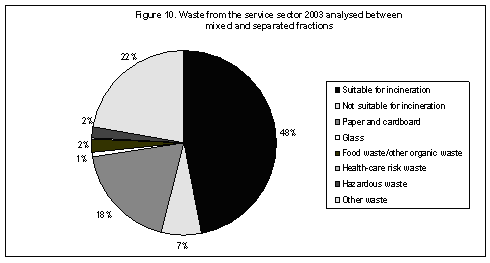
Source: ISAG reports 2003. The key is listed clockwise beginning at “12 o'clock”. Waste from the service sector analysed by mixed and separated fractions is shown in Figure 10. The amount of waste suitable for incineration fell from 55 per cent in 2002 to 48 per cent in 2003, and other waste increased from 13 per cent in 2002 to 22 per cent in 2003. Otherwise, there has not been any great changes. Waste suitable for incineration, paper and cardboard, and other waste are the three largest waste fractions from the service sector with 48 per cent, 18 per cent, and 22 per cent respectively. The increase in the amount of waste from the service sector in 2003 is apparent in the fractions: waste suitable for incineration, waste not suitable for incineration, paper and cardboard, glass, hazardous waste, and other waste. These fractions increased by 5 per cent, 7 per cent, 22 per cent, 47 per cent, and 106 per cent respectively compared to 2002. The fractions: food waste/other organic waste and healthcare risk waste show drops of 7 per cent and 11 per cent respectively. 
Source: same as Tables 1 and 2. Note that arisings in 2008 have been set to correspond to arisings in 2003. The figures are not projections of developments in waste arisings. Storage means that the waste in question has been assigned to temporary storage by local authorities (the local council), cf. section 37(3) of the Statutory Order on Waste. Denmark has excess incineration capacity, but storage can be due to e.g. repairs or shut down of operations at installations. Of the 1,655,000 tonnes of waste which the service sector generated in 2003, 44 per cent was recycled, 46 per cent was incinerated, whereas 8 per cent was landfilled and 1 per cent placed in temporary storage, cf. Figure 11. This means that more waste was recycled and less incinerated and landfilled compared to 2002. The waste put in temporary storage will be incinerated when incineration capacity becomes available [21]. In other words, the incineration rate is actually higher than the 46 per cent. This means there has been a diversion of waste volumes from landfilling, incineration and temporary storage to recycling. 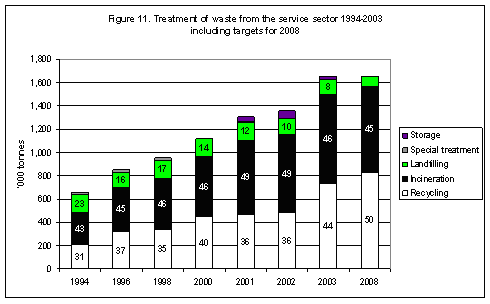
Source: same as Tables 1 and 2. Note that arisings in 2008 have been set to correspond to arisings in 2003. The figures are not projections of developments in waste arisings. As stressed in Chapter 1, the increase in waste arisings from the service sector from 2001 should be regarded with some caution. Compared to the targets for treatment in 2008 in Waste Strategy 2005-2008, Denmark is still recycling too little, and incinerating and landfilling too much waste from the service sector. If the 2008 targets are to be met, separation and collection of waste must be improved so that a larger proportion of recyclable materials can be recycled, and so that environmentally harmful waste types can be separated and treated separately. 5.3 Waste from industryWaste generation from industry amounted to 1,841,000 tonnes in 2003, which is 470,000 tonnes or 20 per cent less than in 2002. As mentioned in Chapter 1, there is however uncertainty as to the increase and it should therefore be regarded with some caution. 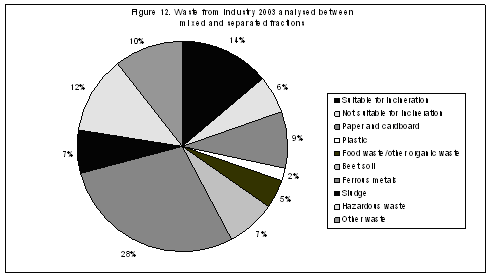
Source: ISAG reports 2003. The key is listed clockwise beginning at “12 o'clock”. Figure 12 shows a breakdown of waste from industry by mixed and separated fractions It is seen that ferrous metals is by far the largest single fraction, followed by the mixed fraction waste suitable for incineration, hazardous waste and other waste. The individual fractions' percentage share of total industrial waste have changed since 2002. The greatest changes are in ferrous metals which fell from 34 per cent in 2002 to 28 per cent in 2003, and in hazardous waste which increased from 7 per cent in 2002 to 12 per cent in 2003. The remaining fractions show changes within 4 percentage points. However, as mentioned above there has been a fall in total industrial waste arisings of around 470,000 tonnes. This fall is primarily due to reductions in the fractions: waste suitable for incineration, waste not suitable for incineration, paper and cardboard, beet soil, ferrous metals, and sludge. These fractions fell by 26 per cent, 27 per cent, 39 per cent, 48 per cent, 31 per cent, and 10 per cent respectively. By contrast, the fractions food waste/other organic waste, plastic, hazardous waste, and other waste have gone up 15 per cent, 1 per cent, 44 per cent, and 16 per cent respectively. In 2002, industry experienced a fall in waste arisings of 12 per cent from 2001; while the service sector saw a 4 per cent rise in waste generation. The shift between the two sectors may be due to incorrect reporting, as the source manufacturing etc. was discontinued from 2001 as a result of amendments to the Statutory Order on Waste [22]. This means that waste from industry must be registered as originating from one of the following 11 subgroups: food, beverages and tobacco; textiles, clothing and leather goods; wood-working and furniture; paper and graphical production; chemicals etc.; rubber and plastic; stone-working, pottery and glass; ferrous metals; other manufacturing; utilities; agriculture, forestry, fishery etc. It is likely that some carriers find it easier to register industrial waste as service-sector waste. Parties reporting to the ISAG are therefore encouraged to be aware of this possible source of incorrect reporting. Another explanation for the shift between the two sectors may be in structural changes, the fact that society is changing from an industrial to a knowledge society. The shift is supported e.g. by the fact that the number of new companies in traditional industry went down during the 1990s while the number of new companies in the knowledge services industry doubled. [23] Treatment of waste from industry is shown in Figure 13. In 2003, 63 per cent of the waste from this sector was recycled. This corresponds to 1,157,000 tonnes in absolute figures. In recent years, the recycling rate has been around 63 per cent. 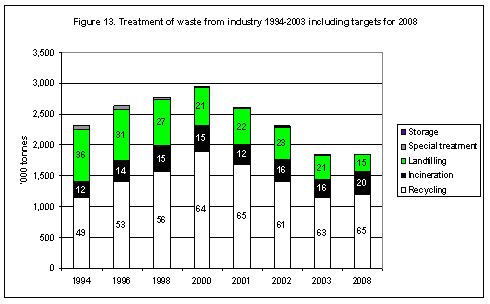
Source: same as Tables 1 and 2. Note that arisings in 2008 have been set to correspond to arisings in 2003. The figure is not intended as a projection of developments in waste arisings. 
Source: same as Tables 1 and 2. Note that arisings in 2008 have been set to correspond to arisings in 2003. The figures are not projections of developments in waste arisings. Storage means that the waste in question has been assigned to temporary storage by local authorities (the local council), cf. section 37(3) of the Statutory Order on Waste. Denmark has excess incineration capacity, but storage can be due to e.g. repairs or shut down of operations at installations. The incineration rate for industrial waste reached 16 per cent in 2003, which is the same figure as in 2002. The landfilling rate has gone down by 2 per cent. This means that the 2008 target of landfilling a maximum of 15 per cent of industrial waste has not been met. Denmark still landfills far too much industrial waste. Even if the rates of recycling and landfilling have taken a positive direction since 1994, there is still some way to go before the 2008 targets for these two treatment options have been met. The volumes and composition of waste from industry depend on the sector generating the waste, as well as size and number of enterprises. Possibilities of waste prevention or recycling will therefore differ from one waste fraction and sector to another. In order to meet the targets in the Waste Strategy 2005-2008, the Danish EPA has selected a number of waste types from industry to come into focus. These waste types include waste from foundries and shredder waste, which are to be diverted from landfilling to recycling whenever environmentally and economically efficient. With the latest amendment to the Statutory Order on Waste the Danish EPA has implemented a number of changes to the ISAG system, so that since 2001 it has been possible to analyse waste from industry between eleven different sectors. In future a number of enterprises [24]must in addition keep a register in a specific format with various information on their waste generation. This will enhance the possibility of conducting sector-specific analyses and initiatives in industry. 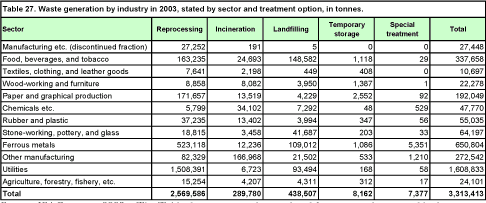
Source: ISAG reports 2003. The Table does not cover beet soil and ferrous metals reported by large scrap dealers. Waste generation in industry stated by sector and treatment option can be seen in Table 27. As apparent from the table, food, beverages, and tobacco; the ferrous metals industry; other manufacturing; and suppliers contributed 87 per cent of waste from industry in 2003. At the same time it is seen that the amount of waste from manufacturing etc. constitutes 27.448 tonnes. In 2002, waste generation from this sector amounted to 238,815 tonnes, which means that reporting enterprises have improved their reporting on the new commercial sources (cf. as the commercial source manufacturing industries etc. was discontinued in 2001). 5.4 Waste from building and construction activitiesGeneration of waste in the building and construction sector was smaller in 2003 than in 2002. Construction and demolition waste reached 3,785,000 tonnes, which is 259,000 tonnes, or 6 per cent, less than in 2002. The fall is apparent in the fractions: not suitable for incineration, concrete, tiles, soil and stone, and other recyclable waste. These fractions fell by 24 per cent, 0.1 per cent, 13 per cent, 36 per cent, and 6 per cent respectively. The fractions other construction/demolition waste, asphalt, and other waste increased by 30 per cent, 28 per cent, and 19 per cent respectively. In 2003, 476,278 fewer tonnes of soil and stone were reported. This is explained e.g. by the fact that the large operators in this area reported a significant decline in the market in the first half of 2003, leading to less waste from this fraction being received as opposed to in 2002. The second half year was reported as normal. By far the major part, or 93 per cent, of waste generated by the building and construction sector is recycled. The breakdown by treatment option in 2003 shows that the recycling rate increased by 1 per cent compared with 2002, whereas the landfilling rate went down by 2 per cent. The incineration rate was 2 per cent, cf. Figure 14. 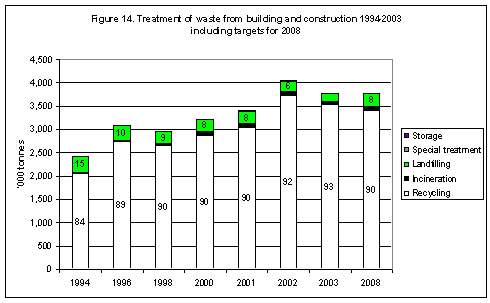
Source: See Tables 1 and 2. Note that arisings in 2008 have been set to correspond to arisings in 2003. The figures are not projections of developments in waste arisings. As the figure shows, the recycling rate for construction and demolition waste increased by 9 percentage points in the period 1994 to 2003. At the same time the landfilling rate dropped 11 percentage points. The figure also shows that the distribution of waste between the different treatment options has been in line with targets for 2008 since 2000. 
Source: same as Tables 1 and 2. Note that arisings in 2008 have been set to correspond to arisings in 2002. The figures are not projections of developments in waste arisings. The high recycling rate for construction and demolition waste is due partly to the fact that recycled waste, unlike landfilled or incinerated waste, is exempt from taxation, and partly due to a departmental circular on municipal regulation concerning the separation of construction and demolition waste intended for recycling [25]. In addition, the Danish Ministry of Environment and Energy (now Ministry of the Environment) and the Danish Contractors' Association entered an agreement on selective demolition of buildings so that waste is sorted at an early stage. Figure 15 shows construction and demolition waste analysed between mixed and separately collected fractions in 2003. It is seen that the major part of separated building waste consists of concrete, asphalt, soil and stone. 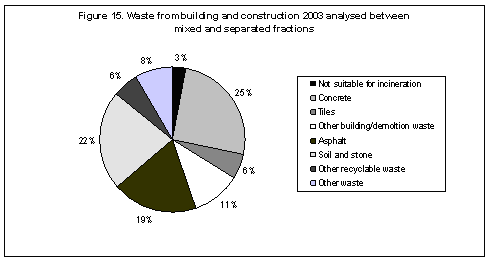
Source: ISAG reports 2003. The key is listed clockwise beginning at “12 o'clock”. A large part of the waste from the building and construction sector is reprocessed at mobile crushing plants which are used for different assignments at different locations throughout Denmark. The owner of the mobile crushing plant is responsible for the ISAG reports to the Danish EPA, but sometimes the entrepreneur also reports the waste. The Danish EPA is very much aware of this possible source of double reporting, and great efforts are being made, in co-operation with the providers of the reports, to ensure quality control and avoid double reporting. 5.5 Residues from coal-fired power plantsThe generation of residues at coal-fired power plants varies from one year to the next due to variations in Danish imports/exports of electricity to and from Sweden and Norway. Imports/exports of electricity to and from Sweden and Norway depend largely on precipitation in these countries - if there is much precipitation, much electricity is generated from hydropower in Sweden and Norway, and Danish exports will be correspondingly lower. For example, in 1996 exports of power were particularly high, which is reflected in amounts of residues in this year, cf. Figure 16. In 2000, there was high precipitation in Sweden, which resulted in so much cheap hydroelectricity on the market that power stations in both Denmark and Norway had to cease operations temporarily. Amounts of residues have decreased steadily since 1996, but show an increase from 2002 to 2003. The decrease is mainly explained by the last 10 years' strategy to phase out coal, so that in the long term coal will be replaced by natural gas and renewable energy sources, including bio-fuels. Energy statistics [26] reflect that an increasingly smaller share of electricity generation is based on coal. Also in future, the strategy to phase out coal will result in a decrease in residues from coal-based energy generation, whereas there will be an increase in fly ash and bottom ash from bio-fuels. Residues from coal-fired power plants amounted to around 1,473,000 tonnes in 2003, which is an increase of 20 per cent from 2002. As Figure 16 shows, 96 per cent of residues was recycled and 4 per cent was landfilled. The increase is due to the fact that, in net terms, in 2003 Denmark exported 3 times more of electricity than in 2002. [27] 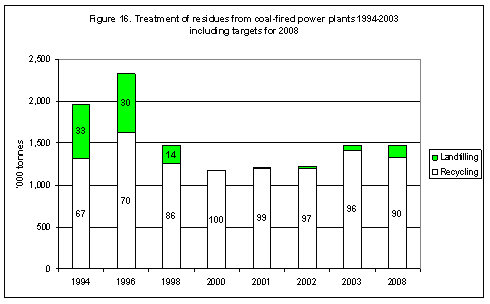
Source: same as Tables 1 and 2. Note that arisings in 2008 have been set to correspond to arisings in 2003. The figures are not projections of developments in waste arisings. 
Source: same as Tables 1 and 2. Note that arisings in 2008 have been set to correspond to arisings in 2003. The figure is not intended as a projection of developments in waste arisings In Table 30 recovery of residues in 2003 is stated in more detail. More than 90 per cent of residues is used as raw materials in industrial manufacture of, for example, cement, concrete and plaster board, whereas the remaining part is primarily used as backfilling, either in accordance with the provisions of Statutory Order no. 655 of 27 June 2001 from the Ministry of the Environment, or as backfilling with special approval under the Danish Environmental Protection Act. 5.6 Sludge from municipal treatment plantsSludge from municipal treatment plants amounted to 1,058,000 tonnes in 2003, which is an increase of 5 per cent, or 47,000 tonnes, from 2002. [28] The statement includes sludge exclusively, which means sand and screenings are excluded. As mentioned above, it was decided to state amounts of sludge for mineralisation with a dry matter content of 20 per cent, so that sludge for mineralisation would be stated with the same dry matter content as other sludge. If stated in wet weight, sludge from municipal wastewater treatment plants would have amounted to about 1,370,000 tonnes in 2002, which is about 672,000 tonnes less than in 2001, corresponding to a fall of 33 per cent. Treatment of sludge from municipal wastewater treatment plants is shown in Figure 17. According to the Figure, 54 per cent of sludge is recycled, 42 per cent is incinerated, and 4 per cent is landfilled. The figures for recycling include 84,400 tonnes of sludge with a dry matter content of 20 per cent, corresponding to 1,125,334 tonnes in wet weight, which are being treated in long-term storage with the objective of further mineralisation. This amount has been included in the amounts for recycling because the sludge will be recycled after a number of years in storage. In the treatment in sludge mineralisation plants (long-term storage) sludge is reported with around 0.5 - 1 per cent dry matter content, whereas alternatives typically contain 20 per cent. 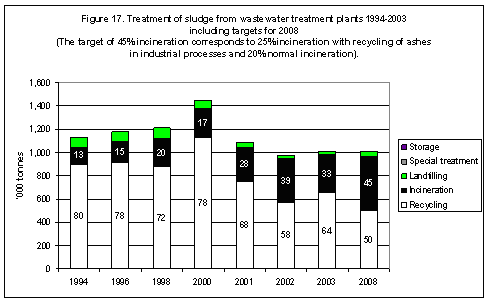
Source: same as Tables 1 and 2. Note that arisings in 2008 have been set to correspond to arisings in 2003. The figures are not projections of developments in waste arisings. The figure shown for 2003 is based on 2002 figures. The method of calculation of sludge for mineralisation has been changed with effect from 2001. The figures for recycling include 84,400 tonnes of sludge with a dry matter content of 20 per cent, corresponding to 1,125,334 tonnes when stated in wet weight. Long-term storage and incineration amounts include 139,555 tonnes for other uses (Carbogrit and production of concrete). 
Source: same as Tables 1 and 2. Note that arisings in 2008 have been set to correspond to arisings in 2003. The figures are not projections of developments in waste arisings. The figure shown for 2003 is based on 2002 figures. Sewage sludge is mainly recovered as fertiliser on farmland. In recent years, the requirements regarding contents of certain organic and chemical substances in sludge applied to farmland have been made more strict. In the short term, the rate of recycling is therefore expected to decrease. In the long term, it is expected the general phase-out policy for xenobiotic substances will improve the quality of sludge further. Finally, it appears that alternative methods of sludge recovery are being discovered to an ever greater extent. After sludge incineration, the inorganic residue is recovered in the production of e.g. sand blasting agents, or cement. Sludge recovered by such alternative methods in 2002 [29] amounted to around 140,000 tonnes. In Figure 17, the around 222,000 tonnes have been included in incineration because it is recovery, not recycling. 5.7 Residues from waste incineration plantsFigure 18 shows amounts of residues (slag, fly ash, and flue-gas cleaning products) from waste incineration plants 1994 to 2003 in tonnes, including treatment option. Residues from waste incineration plants have not been included in calculations of total waste generation, since the waste would then be counted twice in the statistics. However, residues are a large waste fraction and to secure adequate capacity for their treatment, a calculation of amounts is required. By far the largest part of residues is recycled. The recycling rate was 97 per cent in 2003 which is 1 percentage point more than in 2002. Residues, however, are not recyclable when containing large quantities of heavy metals, which may leach into the environment and the groundwater. In such cases landfilling is required. 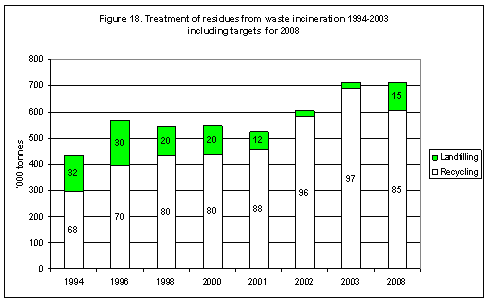
Source: See Tables 1 and 2. Note that arisings in 2008 have been set to correspond to arisings in 2003. The figures are not projections of developments in waste arisings. Note that Figure 18 is not comparable with Table 33 and Figure 19, because Figure 18 is exclusive of exported residues. 
Source: same as Tables 1 and 2. Note that arisings in 2008 have been set to correspond to arisings in 2003. The figures are not projections of developments in waste arisings. Contaminated fractions such as PVC, impregnated wood, and electric and electronic products, are not to be incinerated. This means that contents of heavy metals in slag will be reduced significantly. However, requirements for recycling of slag were tightened in 2000 to take account of the groundwater. The 2008 target of 85 per cent recycling has already been met. Table 33 shows the uses of residues from waste incineration. Naturally, amounts of residues depend on the amount of waste incinerated. Slag and flue-gas cleaning products typically comprise around 20 per cent and 5 per cent, respectively, of the waste amount led to incineration. Due to temporary storage at incineration plants amounts can, however, shift from one year to the next. Table 33 shows that residues from waste incineration amounted to around 733,000 tonnes in 2003. This is 105,000 tonnes more than in 2002. Out of the 733,000 tonnes of residues removed from waste incineration plants, around 245,000 tonnes were landfilled, while around 629,000 tonnes were recycled. This means that, in reality, the stored amounts of fly ash and flue-gas cleaning products have been reduced by about 141,000 tonnes. 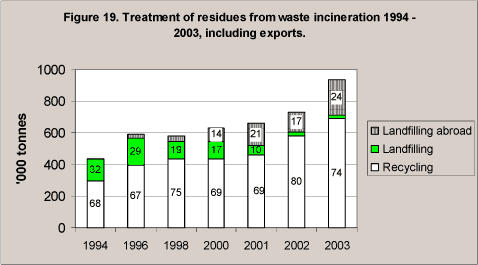
Source. ISAG reports and registrations under the EU regulation on shipments of waste. As is evident in Figure 19, the amount of residues exported for landfilling abroad has been increasing since 1996. The amount of residues exported for landfilling went up from 21,000 tonnes in 1996 to 226,000 tonnes in 2003. The main part of this amount has been excavated from landfills in Denmark, as evident in Figure 33. From 1996 to 2003, amounts of landfilled residues have increased by 27 per cent and the recycling rate has increased by 64 per cent. 6 Incineration plants and landfills6.1 Incineration plantsIn 1999, total waste incineration capacity was around 2,698,000 tonnes, distributed between 31 plants, cf. Table 34. This is an increase in capacity of 225,000 tonnes compared to the 1996 capacity. In the early 1990s, an extensive conversion of waste incineration plants from heating generation to combined power and heating took place. In this connection, capacity adjustments were effected in relation to expected waste volumes for incineration in the future. As a result of the ban on landfilling of combustible waste that took effect on 1 January 1997, there is now increasing pressure on incineration capacity. Volumes of non-recyclable waste suitable for incineration will be surveyed regularly in order to ensure the necessary incineration capacity. In 2003, there were 32 waste incineration plants in Denmark.
Source: Rambøll & Hannemann 1990: Analysis of data for energy plants based on waste, for the Danish EPA and the Danish Energy Authority. The Danish EPA and the Danish Energy Authority 1994:
Waste ressources for waste incineration 1993 and 2000. The Danish EPA and the Danish Energy Authority 1997: Waste for incineration year 2000. The Danish EPA and the Danish Energy Authority 2001.
Waste incineration in 2004 and 2008. Volumes and capacities. Environmental Review No. 11, 2001. 6.2 Landfill sitesIn the Statutory Order on landfills [30], a landfill is defined as waste disposal facilities on land for the landfill of waste that are covered by K1b, K3a, K3b or K3c in Annex 1 of the Statutory Order on Approval of Listed Activities [31]. This definition includes landfills (including controlled landfills), inert waste landfills and mono-landfills. Today, there are 134 landfill facilities in Denmark with an environmental approval, according to a questionnaire study conducted by the Danish EPA in February/March 2001, cf. Table 35. Of these, 100 facilities are owned by public authorities, whereas 34 are under private ownership. The 100 public facilities cover 51 landfills, 25 inert waste landfills, and 24 mono-landfills. The privately owned facilities cover 3 landfills, 10 inert waste landfills and 21 mono-landfills. 
Source: Danish EPA: Working Report No. 54, Landfill Capacity 1992. Danish EPA 1997: Working Report no. 33, Landfills in Denmark, plus own calculations. Questionnaire study carried out by the Danish EPA in February/March 2001. 7 New indicators for loss of resources and environmental impactTo date, Denmark's environmental initiatives have been measured in terms of waste volumes. Denmark is one of the few countries in the EU which has been able to state its waste treatment and its total waste generation in tonnes for each year. A high level of recycling has typically been the criteria for good initiatives. In future, focus will continue to be on waste volumes, however initiatives will be based on an improved decision basis that links the environmental problems with the actual tonnage of waste Denmark in fact produces. Denmark has therefore developed and calculated a number of new indicators to inform us about the impacts on resources and the environment from waste. These indicators calculate resource and energy consumption, as well as landfilling demands for a number of different treatment options. Initially, we have calculated indicators for 22 materials found in waste. The purpose of the new indicators is to gain a better foundation for making decisions about waste management. The new indicators will enable us to prioritise and calculate whether it is better, in terms of the environment and resources, to recycle or incinerate a particular waste fraction. Unfortunately, existing data does not permit us to determine the size of the environmental benefit that would result from investing efforts in avoiding waste generation all together through waste-prevention initiatives. As of yet, our statistical base remains insufficient for this purpose. We will continue to use the amount of waste as an indicator for how well we are doing in the area of waste management. It is a simple indicator which is easy to use. However, this indicator will no longer stand alone. It will be supplemented by calculations of how many resources are lost with the waste; from the time the raw materials are recovered and the products produced through to when the waste is recycled, incinerated or landfilled. The first generation of these new indicators was published with Waste Strategy 2005-2008. However, we will only reap the full benefits of the new indicators once a series of indicators is available, calculated over a number of years. 7.1 Waste arisings and economic developmentThe challenge is to decouple the increase in waste volumes from general economic growth. Responsibility for solving the problem of increasing volumes of waste is shared by all sectors of society. Our initial goal is thus to ensure that the increase in waste generation does not occur at the same rate as the increase in economic development. Figure 20 shows that total waste arisings increased faster than economic growth in the period 1995 to 1996. This was followed by a decline in arisings, and yet another increase during 1999 to 2000. Since 2000, waste arisings seem to have been fairly stable. However, this applies only for total waste arisings. Waste generation is the result of all activities in society. If total waste generation is shown in proportion to gross national product (GNP), it provides an indication of the waste intensity in society. 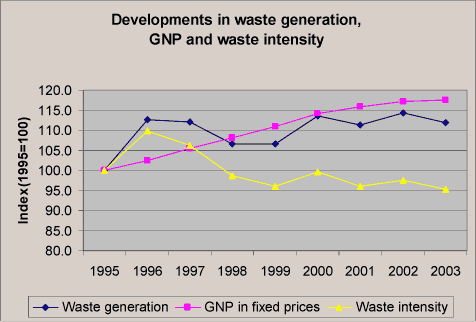
Figure 20. Development in waste generation compared to the economic development. The graph shows the relative changes in gross national product in constant prices [32] (GNP) and waste generation, as well as waste intensity, which is the relationship between the relative change in waste generation and the relative change in GNP. As can be seen from the figure, waste intensity declined until 1999 (decoupling), and subsequently waste intensity has been relatively constant, apart from a slight downward trend. This means that, by and large, the growth in waste arisings has corresponded to the growth in GNP since 1999. This development therefore does not indicate a decoupling; rather it indicates a fairly stable relationship between growth in waste volumes and economic growth, stated as GNP. Since waste arisings in a number of sectors are increasing, it is important to continue to work towards reducing the volumes of waste. Forecasts for future waste generation show that waste volumes will increase, unless active efforts are made to reduce them. This can be seen, for example, in the European Environment Agency's report, “Environment in EU at the turn of the century”. 7.2 New indicators for loss of resources and environmental impactNew waste indicators have been developed and calculated for resource loss and landfill requirements for 22 materials found in waste. These indicators express the environmental benefit associated with moving a particular waste fraction from landfill to recycling or incineration. This means that the loss of resources and energy when the entire waste fraction is landfilled is calculated for each material type and compared with a new treatment situation in which a realistic proportion of the waste fraction is either recycled or incinerated [33]. The indicators are calculated on the basis of waste arisings in 2000, and future arisings have not been forecast. The indicators can be used in environmental prioritisation of efforts with regard to the individual fractions, in that they can suggest whether it is more cost-beneficial, in terms of the environment and resources, to recycle waste or to incinerate it. In this way, the new indicators can be used to determine where we will achieve the minimum environmental impact. Furthermore, the indicators also constitute an important basis when we are to calculate the quality of waste management efforts. With the help of these new indicators we can designate specific areas to be the focus of future efforts. The first calculations of the indicators are available and can serve as a foundation for new initiatives. However, it is important to note that more thorough environmental and economic analyses of initiatives will be carried out before specific initiatives are implemented. The new indicators require a comprehensive LCA [34]data basis, a survey of material flows, and complicated calculations. Therefore, they are linked to some uncertainty. The method and statistical base have been through a thorough review and it has been concluded that the indicators undoubtedly provide a more accurate picture of the real environmental impacts than is the case for other existing indicators based only on waste volumes. However, the indicator for landfill requirements is extremely uncertain. Due to a lack of LCA data, it has not been possible to calculate the indicators for all waste fractions. Neither do the indicators include calculations of toxic effects, since there is no data basis in this area. It is therefore vital that the indicators are supplemented by a qualitative assessment of hazardous emissions from the processes in each material's life cycle, before any final decisions about new initiatives are made. New treatment methods have been developed for the fractions environmentally harmful PVC and impregnated wood. However, LCA data is not available for these processes, so the methods have not been included in the calculation of the indicators. 7.3 DefinitionsFor each selected material, the following three indicators have been calculated:
Resource consumption is stated in person-reserves (PR). Person-reserves are an indication of the quantity of the material in question available per person. (For non-renewable resources, the available quantity is calculated per person in the world. For renewable resources, however, the available quantity is calculated per person in the region.) Energy consumption is calculated in person-equivalents (PE). Person-equivalents correspond to the amount of energy (primary energy) consumed per person per year. Landfill requirements are also expressed in person-equivalents. In this case, a person-equivalent corresponds to the amount landfilled per person per year. 7.4 Materials and treatment optionsThe indicators are based on waste arisings in 2000, and waste management that year. Waste volumes led to landfills, incinerated, recycled and re-used are shown in Figure 21. As the figure shows, we landfill considerable volumes of paper and cardboard, impregnated wood and plaster. Paper and cardboard, wood, organic domestic waste and the many contributions from various plastic materials comprise the largest volumes of waste led to incineration. The largest volumes recycled are concrete, tiles, asphalt (including re-use), paper and cardboard, sludge, and iron and steel. 7.5 Indicator for resource savingsFigure 22 shows the amount of resources saved from existing waste treatment compared to a situation in which all waste is landfilled. Resource savings are divided into energy resources and other resources. Recycling of metals has provided one of the greatest contributions to the resource savings already achieved. Lead, tin and zinc are not shown in the figures, since the LCA data necessary to calculate the indicator is not available. However, it is estimated that the resource savings for lead, zinc, and tin would be at the same level as those for the other metals, as these resources have a relatively short supply horizon. Paper, wood, and the six plastic fractions contribute, in particular, to energy resource savings, as their incineration substitutes virgin raw materials in the electricity and heat generation process. The building materials, concrete, tiles and asphalt, are not shown in the figure, since there are no significant resource savings to be achieved from their recycling. This is because concrete, tiles and asphalt substitute resources which exist in plenty. Figure 23 shows the extent to which there is room for improvement, if, for example, we were able to recycle a larger proportion of a given fraction which today is being either incinerated or landfilled. Thus, we have an indicator value that shows how much more we can save resources by improving the way we currently manage our waste. A positive value indicates that an environmental benefit can be achieved, if we are able to save resources by changing existing waste treatment to “optimised waste treatment” involving increased recycling. Calculations include an assessment of how much more waste it would be realistic to recycle. For paper, plastic (excluding PVC), aluminium and copper, Figure 23 shows potential for significant resource savings by increasing the rate of recycling. For wood, resource savings can be achieved by increased incineration of waste wood in waste incineration plants. The figure also shows that we cannot save further resources by recycling greater volumes of organic domestic waste, automobile rubber, and oil than we already do. For PVC, it is assumed that a larger proportion of PVC waste will be landfilled due to environmental considerations, whereby savings in energy resources will be negative. 7.6 Indicators for energy savingsFigure 24 shows the amount of energy saved from existing waste treatment compared to a situation in which all waste is landfilled. Here we see, that we have already saved considerable energy by treating a majority of the materials suitable for incineration. This is an indication of the fact that incineration with energy recovery is an important element in existing waste management. The expansion of electricity-generating waste incineration plants over the last decade is an important contributor to the energy savings already achieved. When electricity is generated at waste incineration plants, natural gas and other fossil fuels are substituted by waste. Figure 25 shows the potential for improvement, if a larger proportion of a given fraction, which today is incinerated or landfilled, is instead recycled. Thus, we have an indicator value that shows how much more energy consumption we can save by improving the way we currently manage our waste. Figure 25 shows that there are further potentials for exploitation of energy resources in our waste. This means that energy resources can be saved from increased recycling of the individual waste fractions. However, this does not apply to organic domestic waste, PVC, and automobile rubber. Efforts to increase the recycling rate for aluminium and paper are a prerequisite to saving more energy resources. For most of the plastic materials, as well as for glass packaging, minor energy savings can be gained from an increased recycling rate in place of incineration. The great potential for further energy savings from treatment of waste wood is due to the fact that calculations are based on increased incineration in place of landfilling. 7.7 Indicators for landfill requirementsThe indicator values for landfill requirements are extremely uncertain. Figure 26 shows how much we have been able to reduce the landfill requirement through waste management in 2000 compared to a situation in which all waste is landfilled. The indicator value showing savings in landfill requirement indicates that existing waste management helps prevent large amounts of waste from being landfilled. Where possible, the indicator also includes the so-called “hidden material flows”. Hidden material flows are included in data on extraction of coal, and partly also in data on extraction of metals. Thus, the process of extraction of new materials or energy in order to replace materials lost to landfilling or incineration in itself involves producing waste which must be landfilled. For most of the metals the landfill requirement in connection with extraction of ore is significant. However, since data for the hidden material flows is insufficient, these have generally not been included in the calculations. If the hidden material flows were included in all calculations, figures would show significant potentials for reducing landfill requirements for most of the metals by increasing the rate of recycling. Figure 27 shows the potential for improvement, if a larger proportion of a given fraction, which today is incinerated or landfilled, is instead recycled. Thus, we have an indicator value that shows how much more landfill requirement we can save by improving the way we currently manage our waste. Glass and aluminium represent significant potentials for reducing landfill requirements, since the incineration of glass that is not recycled generates slag which, in turn, requires landfilling. Aluminium in thicknesses typically found in household waste, is not incinerated, and therefore does not contribute to the amount of slag. For several of the materials there is an increased landfill requirement. The increase in amounts of concrete, tiles, and PVC requiring landfilling is due to the fact that the demand for increased separation of contaminants in landfilled waste has been taken into consideration in the determination of future waste management. The demand for increased separation is in relation to the situation in 2000. For these fractions, there has been a change from recycling to landfilling. Results should be interpreted with caution, since the indicators comprise many different types of waste which have not been assessed according to their potential environmental impacts. 7.8 The new indicators in summaryWaste treatment in 2000, involving 66 per cent recycling, 24 per cent incineration, and 10 per cent landfilling, resulted in significant savings in resource consumption for waste consisting of paper and cardboard, wood, and the metals aluminium, iron and steel, as well as copper. Significant energy savings have been achieved from existing waste treatment of paper and cardboard, wood, PE plastic, aluminium, and iron and steel. Savings in landfill requirements from existing waste treatment cover almost all waste fractions, excluding impregnated wood, PVC, and sheet glass. The most important potentials for further savings in resource and energy consumption are in metals, paper, and plastic (excl. PVC). The greatest potentials for further savings in landfill requirements are in glass packaging and aluminium. 7.9 ConclusionThe development and calculation of the new indicators marks the onset of a valuable process. A process that will provide greater and more detailed knowledge on the environmental impacts of waste. The indicators contribute to a better foundation for making the right decisions in the waste area This is only the beginning of the process, and some years will have to pass before the indicators can serve as a well-developed and comprehensive tool for making priorities with regard to waste initiatives. However, this is the first step towards developing the proper tool, which will ensure better quality in Danish waste management. In combination with other knowledge on waste and socioeconomic calculations, the indicators are a good foundation for finding the most cost-effective solution for the environment. New indicators for additional environmental effects must be developed in future, and the data basis must be enhanced. Indicators already calculated must be updated on a regular basis to help ensure that the most environmentally beneficial waste treatments are used. 8 Projection of waste arisings8.1 Model suitability for describing historical developmentsSection 8.2 presents a baseline projection of waste arisings up to 2020. The so-called Risø model has been used for the projection. The projection is based on prospects in Finansredegørelse 2001 (Medium Term Economic Survey 2001), the latest projection from March 2001 from the Danish Energy Authority, and an adjustment of the model to accord with ISAG data for 2000. Before making the projection, the suitability of the model for describing historical developments in waste generation was evaluated. This was done by adjusting the model to accord with Waste Statistics 2000, and applying it to calculate developments in waste arisings from 1994 to 2000. Actual waste arisings for the period 1995 to 2000 increased by about 14 per cent . [35]However, model calculations show total waste arisings as unchanged. A significant part of this deviation is due to the fact that the model calculates a larger decrease in the generation of residues from coal-fired power plants than was actually the case. As to arisings stated endogenously [36] in the model, economic developments may explain around half of the increase in total arisings from 1995 to 2000. Around 250,000 tonnes of the deviation of 977,000 tonnes in 1995 may be explained by a larger collection of garden waste, which is described exogenously in the model [37] in the model. In addition, the increase in recyclable fractions is considerably larger than the decrease in the generation of “various non- combustible waste”. A significant part of this increase is due to increased recycling of construction and demolition waste. If this is taken account of, there is a deviation in 1995 of around 400,000 tonnes between the model and actual generation registered. This deviation is due to significantly higher generation in 2000, particularly in the fractions ferrous metals, wood, soil and stone and sludge. 8.2 Baseline projection of waste arisings 1994 to 2020The baseline projection of waste arisings predicts an increase in total waste arisings from 2000 to 2020 of 27 per cent, corresponding to an increase from 13 million tonnes in 2000 to 16.5 million tonnes in 2020, cf. Figure 28 [38]. The baseline projection describes expected developments in waste generation on the basis of estimated economic activity. It is assumed that no new waste political initiatives will be launched. However, an increase is expected in production and consumption of 43 per cent and 53 per cent respectively. Thus, the model projects waste generation to increase less than economic activity. Significant reasons for this are the decreasing use of coal at power plants and expected low growth in building and construction activity. As Figure 28 shows, the baseline projection estimates a steeper increase in the volumes of “combustible” waste and “non-combustible” waste than in recyclable fractions such as paper and cardboard, glass, and plastic. Amounts of ferrous metals and automobile tyres are expected to show a relatively high increase due to the expected increase in industrial production and the expected increase in private consumption of transport. The modest increase in volumes of slag is due to an expected relatively constant coal consumption in the period. Volumes of beet soil are expected to decrease due to new technologies causing less soil to stick to the beets during harvesting. However, depending on weather conditions during harvesting there are normally large variations over the years. Volumes of sludge from municipal wastewater treatment plants are expected to increase due to new treatment technologies causing water contents in the sludge to increase with an unchanged amount of dry matter. This is expected to lead to an increase of 500,000 tonnes in the next five years without a corresponding increase in dry matter volumes. This means that the rate of waste for recycling will decrease from around 64.8 per cent in 2000 to around 62.5 per cent in 2020. Correspondingly, the rate led to incineration will go from around 24 per cent in 2000 to around 26.4 per cent in 2020. The rate led to landfill will remain relatively constant at around 11 per cent, cf. Figure 29. 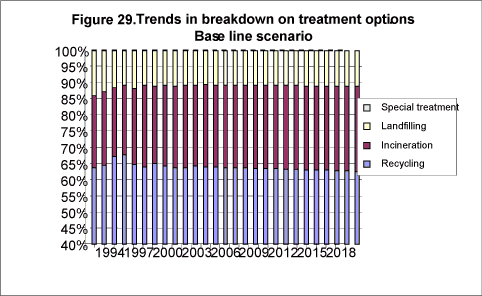
Annex 1 Tables of waste generationTable 1. Waste generation in Denmark in 2001, 2002 and 2003, and targets for 2008, stated by source and treatment option. Stated in '000 tonnes and in per cent. Table 2. Waste generation in Denmark in 2001, 2002, and 2003 stated by waste type and treatment option. Stated in tonnes and in per cent. Annex 2. Principles for distribution of waste received at recycling centres and transfer stations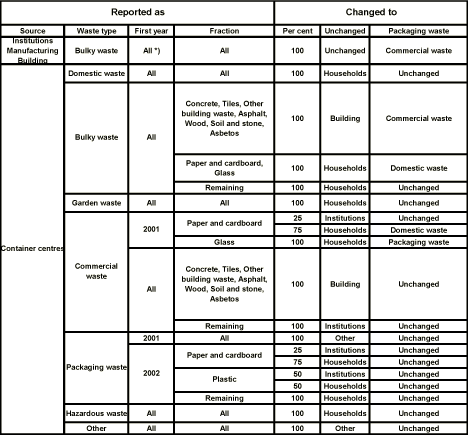
Appendix 3. Statement of organic waste for composting, wood chipping and biogasificationWaste from the following plants have been included under the various categories: Reprocessing of organic waste (53.00) from all sources into animal foodstuff. Reprocessing of organic domestic waste (53.00) from households (source 1) for composting. Reprocessing of organic domestic waste (53.00) from households (source 1) for biogasification. Reprocessing of organic waste (53.00) from remaining sources for composting. Reprocessing of organic waste (53.00) from remaining sources for biogasification. Reprocessing of sludge (83.00) for composting. Reprocessing of sludge (83.00) for biogasification. Branches, leaves, grass (54.00) for composting/wood chipping. Annex 4 Hazardous waste generationFootnotes [1] Statutory Order no. 619 of 27 June 2000 on waste [2] Statistical Ten-Year Review 2003. Statistics Denmark. [3] Developments from 1994 to 2003 are described in more detail in section 1.5 [4]In Waste Statistics 2002, the commercial sources with codes 20-30 (previously called manufacturing etc.) are called industry. [5] Statutory Order no. 619 of 27 June 2000 [6] Statistical Ten-Year Review 2003. Statistics Denmark. [7] The statement for 2003 from municipal wastewater treatment plants of the amount of sludge applied to farmland and incineration of sludge at sludge incineration plants is not yet available. For recycling and incineration, 2002 figures from the Danish EPA's sludge statistics have been used, whereas for landfilling ISAG figures for year 2003 have been used. See “Sewage sludge from municipal and private wastewater treatment plants in 2002”. Environmental Review No. 5, 2004, Danish EPA. [8] Preliminary figures from the Danish Energy Authority on energy generation and consumption, and CO2 emissions in 2003. [9] The Danish Energy Authority's, monthly electricity statistics. [10] Exemption clause in Section 37(3), Danish Statutory Order on Waste (Statutory Order No. 619 of 27 June 2000). [11] Note that organic domestic waste must be assigned to incineration. However, for islands that are not connected by land to an incineration plant there is an exemption from this duty of assignment. [12] Reporting of packaging waste to the EU. [13] The amount reported in 1998 is probably 20,000 tonnes too high due to double reporting. [14] Statistics for waste plastic packaging in 2002 Environmental Project No. 936, 2004. [15]There is a minor fall in the consumption of glass packaging from 2001 to 2002. Statistics on glass packaging 2002, Danish EPA, Environmental Project No. 935, 2004. [16] Statistics on glass packaging 2002. The Danish EPA. Environmental Project No. 935, 2004. [17] It should be noted that today shredder waste is reported as landfilled waste exempted from tax. [18] Council Regulation No. 259/93 on the supervision and control of shipments of waste within, into and out of the European Community [19] Exemption clause in Section 37(3), Danish Statutory Order on Waste (Statutory Order No. 619 of 27 June 2000) [20] The service sector covers the source: institutions, trade and offices. [21] Exemption clause in Section 37(3), Danish Statutory Order on Waste (Statutory Order No. 619 of 27 June 2000) [22] Statutory Order on Waste (Statutory Order no. 619 of 27 June 2000) [23] Statistical Ten-Year Review 2003. Statistics Denmark. [24] Enterprises subject to notification and approval, cf. Appendix 1 to Statutory Order no. 367 of 10 May 1992 on other activities than listed activities, with later amendments, and Appendix 1 to Statutory Order no. 646 of 29 June 2001 on approval of listed activities. [25] Circular No. 94 of 21 June 1995. [26] The latest Energy Statistics are found on www.ens.dk, the Danish Energy Authority's website. [27] Danish Energy Authority Monthly Electricity Statistics. [28] The statement for 2003 from municipal wastewater treatment plants of amounts of sludge applied to farmland and incineration of sludge at sludge incineration plants is not yet available due to a reorganisation of the electronic reporting system. For recycling and incineration, 2002 figures from the Danish EPA's sludge statistics have been used: “Sewage sludge from municipal and private treatment plants in 2002.” Environmental Review No. 5, 2004. For landfilling ISAG figures for 2003 have been used. [29] The statement for 2003 is not yet available. [30] Statutory Order no. 650 of 29 June 2001 on landfills. [31] Statutory Order no. 652 of July 2003 on approval of listed activities (ikke den nyeste!) [32] Constant prices are prices for the year adjusted for inflation, and are thus an indicator of real growth. [33]In other words, these indicator values show what is saved when applying a given treatment option relative to landfilling the entire waste fraction in question. [35] Part of the increase is attributable to an extension of the statistical basis. [36] I.e. calculated within the assumptions of the model. [37] I.e. fixed outside the model. [38] Note that e.g. amounts of paper and cardboard are not an expression of the total potential of this fraction, but merely state the amount of paper and cardboard separated for recycling. The fraction “combustible” thus may also contain paper and cardboard and other recyclable fractions.
|